Discover the captivating world of Pilea plants, the largest genus of flowering plants in the nettle family Urticaceae. With an impressive range of 600–715 species, these botanical wonders can be found in tropical, subtropical, and warm temperate regions across the globe (excluding Australia and New Zealand). Renowned for their succulent shade-loving nature, Pilea plants stand out from other Urticaceae with their unique characteristics, such as opposite leaves, adorned with a single ligulate intrapetiolar stipule in each leaf axil, and cymose or paniculate inflorescences.
Not only are they aesthetically pleasing, but many Pilea species are also non-toxic to pets, making them an excellent choice for plant enthusiasts with furry friends around. Join us as we explore different types of Pilea plants, showcasing their diversity and beauty through vivid pictures. Let’s delve into the world of Pilea, where “felt cap” translates into an enchanting botanical experience.
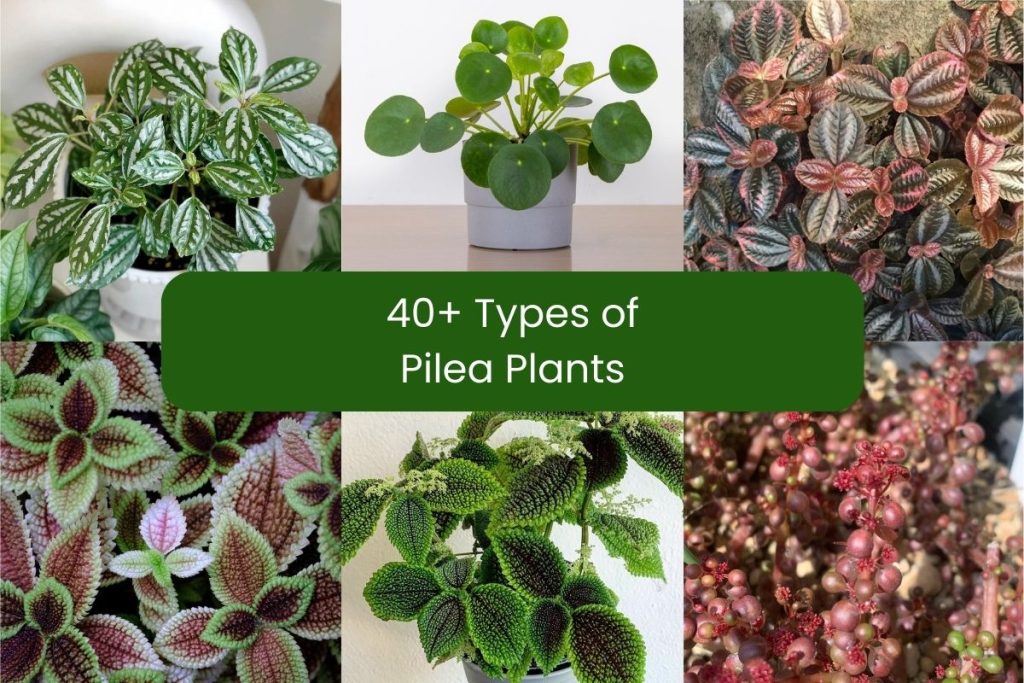
Contents
- 1 Types Of Pilea Plants
- 1.1 Pilea bambuseti
- 1.2 Pilea cadierei
- 1.3 Pilea cavaleriei
- 1.4 Pilea crassifolia
- 1.5 Pilea depressa
- 1.6 Pilea elliptica
- 1.7 Pilea elegans
- 1.8 Pilea fairchildiana
- 1.9 Pilea fontana
- 1.10 Pilea glaucophylla
- 1.11 Pilea grandifolia
- 1.12 Pilea hyalina
- 1.13 Pilea involucrata
- 1.14 Pilea imparifolia
- 1.15 Pilea japonica
- 1.16 Pilea matsudae
- 1.17 Pilea melastomoides
- 1.18 Pilea microphylla
- 1.19 Pilea mollis
- 1.20 Pilea notata
- 1.21 Pilea nummulariifolia
- 1.22 Pilea peperomioides
- 1.23 Pilea peploides
- 1.24 Pilea peltata var. peltata
- 1.25 Pilea peltata var. ovatifolia
- 1.26 Pilea plataniflora
- 1.27 Pilea plataniflora ‘Glossy’
- 1.28 Pilea pteridophylla
- 1.29 Pilea pumila
- 1.30 Pilea pubescens ‘Silver Cloud’
- 1.31 Pilea rotundinucula
- 1.32 Pilea serpyllacea
- 1.33 Pilea serpyllacea ‘Globosa’
- 1.34 Pilea semidentata
- 1.35 Pilea spruceana
- 1.36 Pilea spruceana ‘Norfolk’
- 1.37 Pilea swinglei
- 1.38 Pilea tetraphylla
- 1.39 Pilea tenerrima
- 1.40 Pilea tabularis
- 1.41 Pilea umbrosa
- 1.42 Pilea wightii
- 1.43 Pilea yunquensis
Types Of Pilea Plants
Pilea bambuseti

Pilea bambuseti is a perennial herb with erect stems and glabrous leaves with serrate margins. It grows to be up to 0.8 m high, and its leaves have 14 – 20 teeth on each side, along with numerous lateral nerves. The upper surface of the leaves is smooth and has scattered cystoliths, while the lower surface may have a few spreading hairs on the nerves. Its flowers can be male or female, and it produces an ovoid achene that’s yellow to pale brown.
To propagate Pilea bambuseti, divisions of mature plants or stem cuttings can be taken in spring or summer for successful rooting; alternatively, seeds can also be used for propagation.
Pilea cadierei
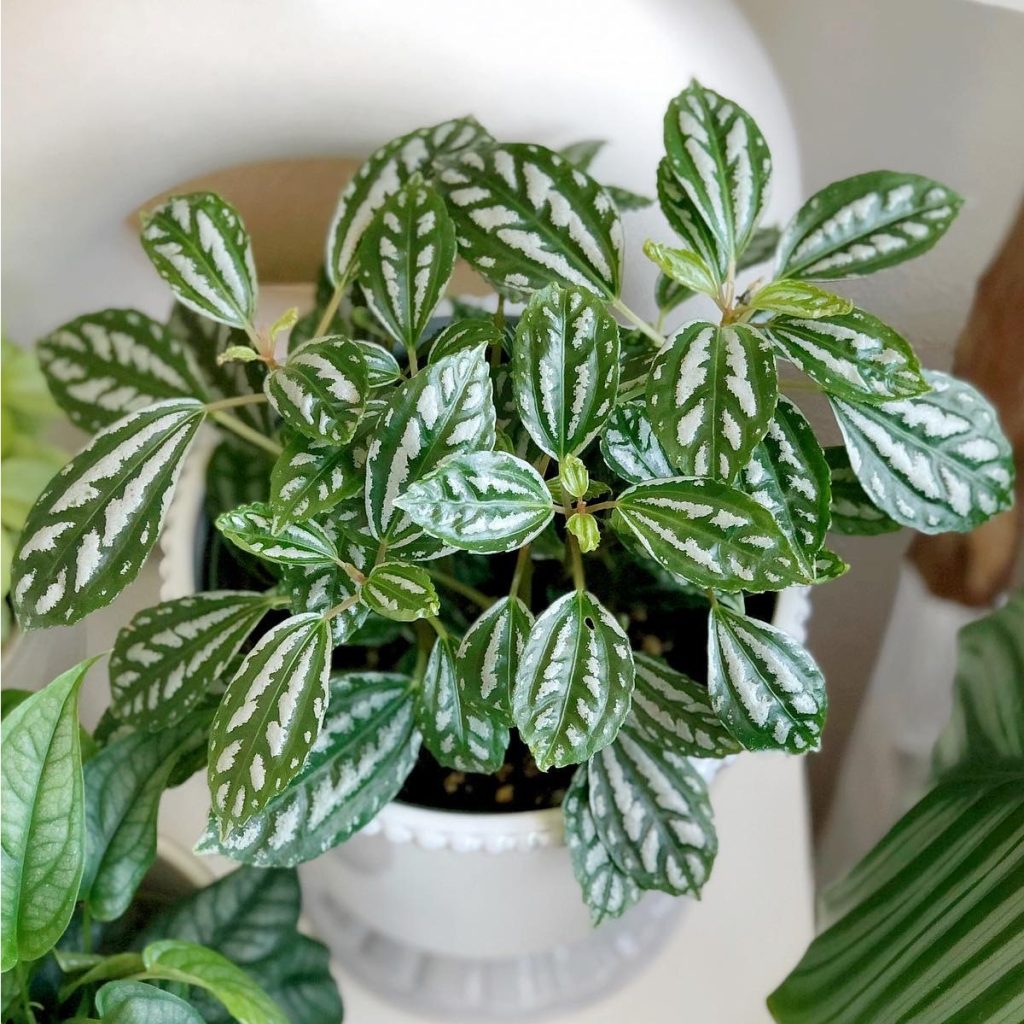
You might recognize the Aluminum Plant or watermelon pilea, botanically known as Pilea cadierei, from its dark-green oval leaves with silvery patches. It grows up to 60 cm tall and features these unique textured-edged leaves with four raised silvery patches. The independent and upright stems are somewhat succulent and may grow woody over time at the base. This perennial can be grown in warmer climates in USDA zones 8-12 either planted directly into the ground or contained.
Propagation methods for Pilea cadierei include division of the rhizomes or stem cuttings taken during springtime with a length of about 10 centimeters. Plant your new propagated pieces into well-draining soil and keep them moist until they have established roots in their new home. Pruning is also advisable to maintain a healthy-looking Aluminum Plant by cutting it back by about 50% during autumn when blooming concludes.
Pilea cavaleriei

You’ll love the unique textured-edged leaves and four raised silvery patches of Pilea cavaleriei. This perennial herb is dioecious, with blue-green stems that are erect, branched, and 1.5-5mm in diameter. Its ovate or rhombic-shaped leaves measure 8-20mm long and 6-18mm wide, with three veins along each side and linear cystoliths visible on both surfaces. It has either male or female inflorescences – males have a few-flowered capitulum while females have clusters of a few flowers – and its achene is ovoid with a smooth surface enclosed by the perianth lobes.
Propagation techniques for Pilea cavaleriei include division or stem cuttings planted in moist soil for best results.
Pilea crassifolia
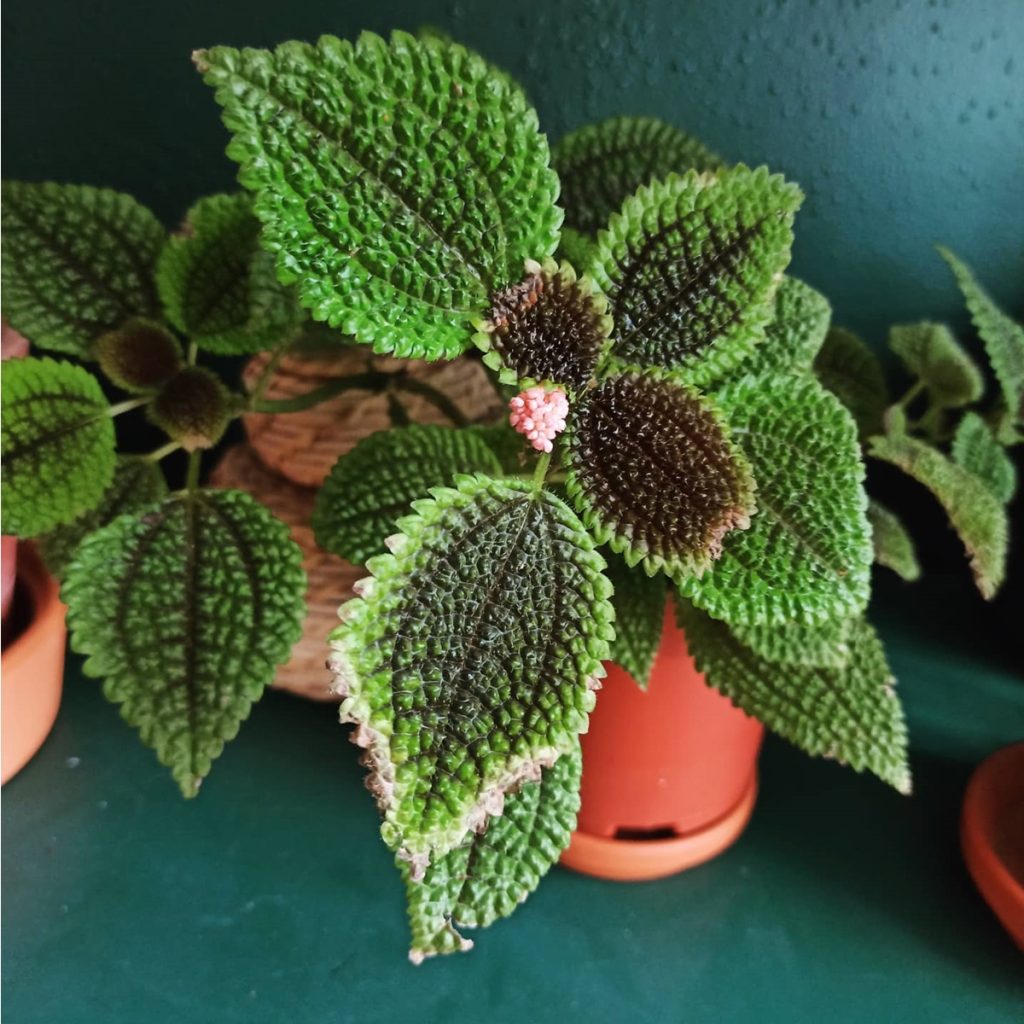
Pilea crassifolia is native to Central and South America, with one popular cultivar being ‘Moon Valley’ for its colorful foliage. This plant can be propagated in a number of ways, including through stem cuttings, leaf cuttings, or division of the root system.
Stem cuttings involve cutting off sections of the stem that have at least two nodes (the spots where new leaves grow from) and putting them in soil to form new roots. Leaf cuttings involve taking a single leaf and burying it in soil so that it grows into a new plant. Finally, division of the root system involves gently separating parts of the existing root ball and replanting them in different pots. All these propagation methods are safe for your plants if done correctly!
Pilea depressa
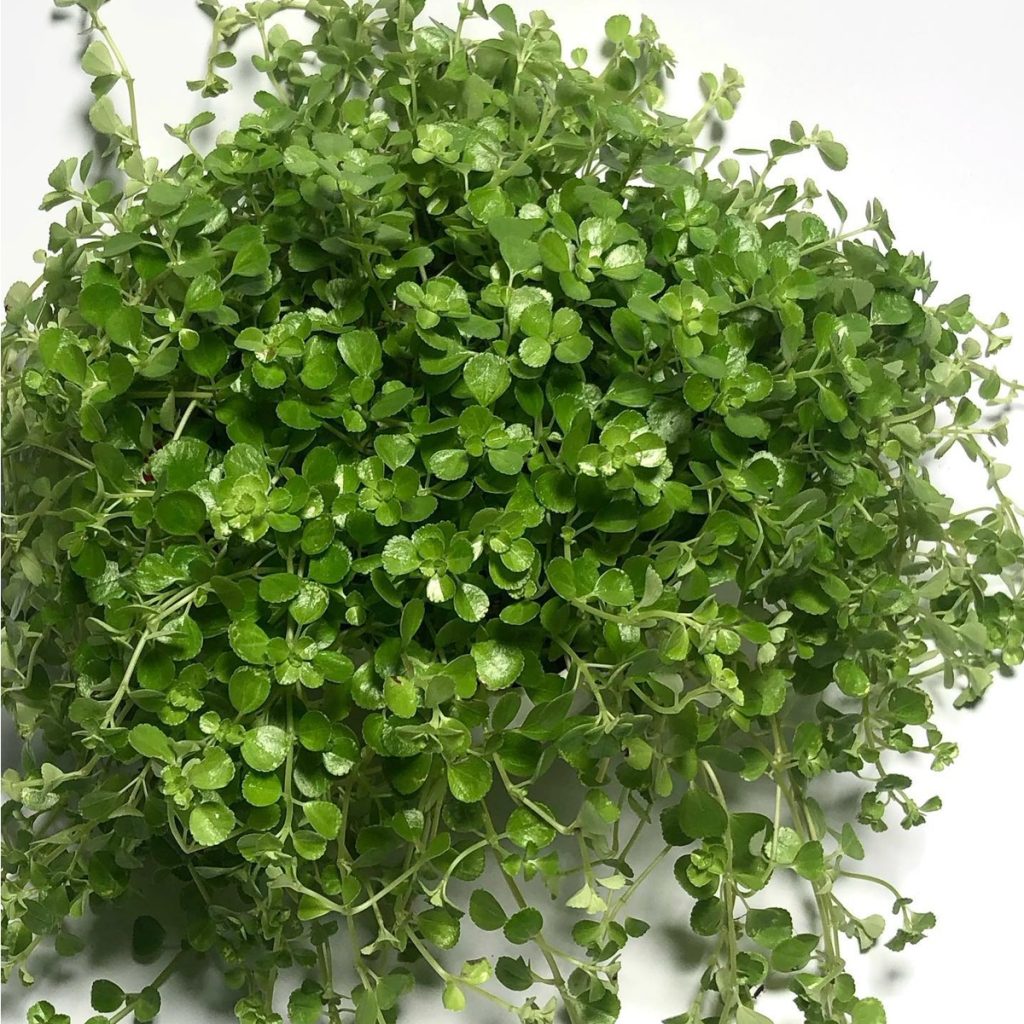
This herbaceous plant grows in Cuba, Dominican Republic, and Haiti and prefers semi-shaded conditions with moderate water. Pilea depressa has round, scalloped leaves that are arranged in opposite pairs along the stems. You can expect this plant to grow at a moderate rate and maintain its evergreen foliage. Its young flush is red while the mature foliage is green. The flowers of this plant are white in color. When propagating Pilea depressa, you should use stem cuttings as your propagation method to ensure the successful growth of the new plants.
Pilea elliptica

Pilea elliptica is a perennial growing up to 30 cm that prefers semi-shaded conditions and moderate watering in USDA Hardiness Zone 9. It’s native to Chile, where it grows best in humid areas with short dry spells. This plant should be grown in the shade or deep ravines with south-facing slopes, providing 80 – 100% shadow for optimal growth.
To ensure proper care of this species, water regularly but do not overwater as it can cause root rot. Do not leave it outside during cold snaps as temperatures below -5°C may damage the foliage and roots. Planting Pilea elliptica in well-draining soil will help keep its roots healthy and strong. With adequate light and moisture, this plant can thrive and bring joy to your home!
Pilea elegans
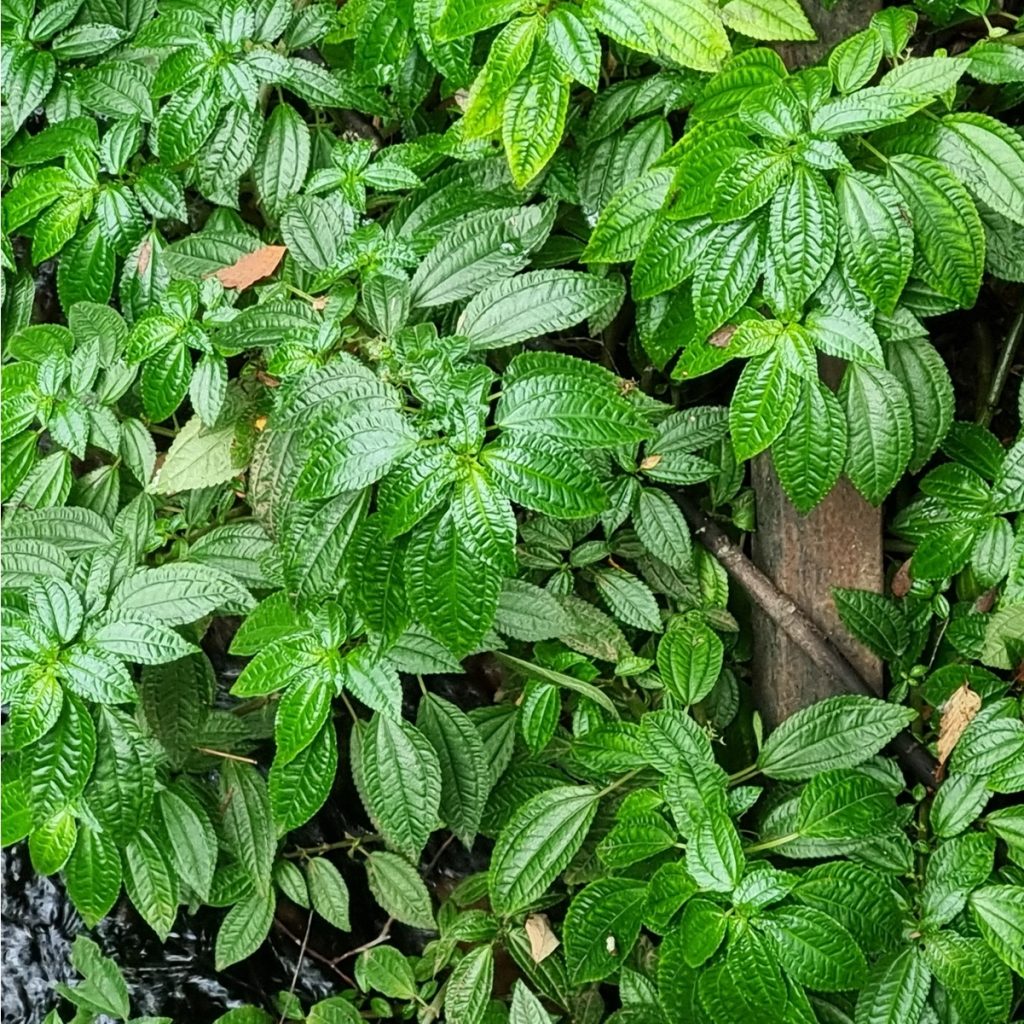
It’s a perennial species in the Urticaceae family, native to Chile and hardy to USDA Zone 9, that enjoys indirect light and tolerates occasional freezing spells. Pilea elegans is an attractive foliage plant with 4-petalled green flowers and can grow up to 80 cm tall. Propagation is easy, as it can be propagated by cuttings or division of the main rootball. For best results, use sterilized cutting tools when taking cuttings from existing plants and avoid planting too deep in the soil so that roots have access to oxygen. Keep in mind that this plant does not tolerate snow, so provide adequate shelter during cold winters if it’s grown outdoors.
Pilea fairchildiana
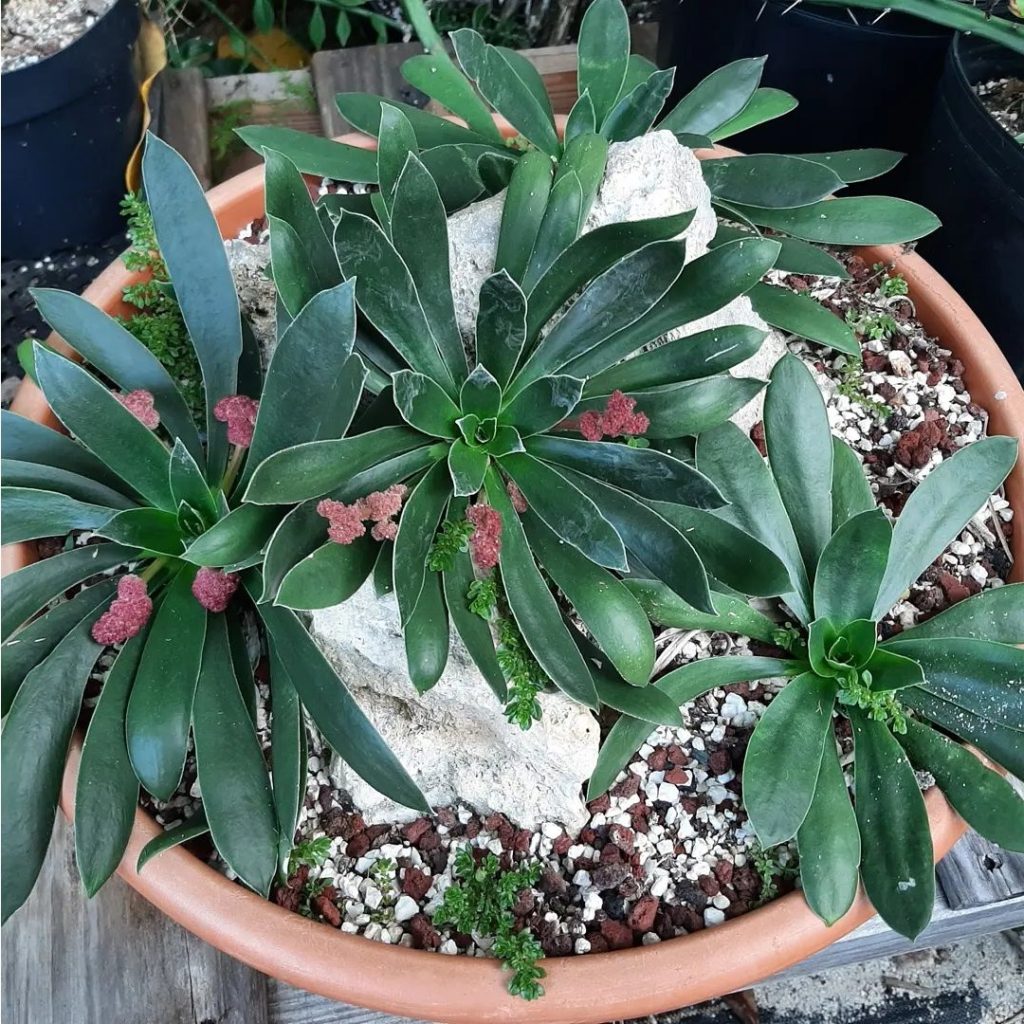
Native to the Constanza Mountains of the Dominican Republic, Pilea fairchildiana is a succulent shrub that can reach up to 12 inches tall. Its alternately arranged leaves are long and tapered, growing up to 6 inches in length with scarce venation due to being filled with water. It has a dioecious reproductive system with tiny, pink, ball-like clustered flowers. This species is usually found at elevations between 500 and 1,500 meters around well-drained cliffs above streams.
Propagation methods for Pilea fairchildiana can be done using stem cuttings or by division of the rosettes when they become too crowded in their container. It requires bright indirect light and should be watered sparingly and not allowed to dry out completely between waterings.
Pilea fontana
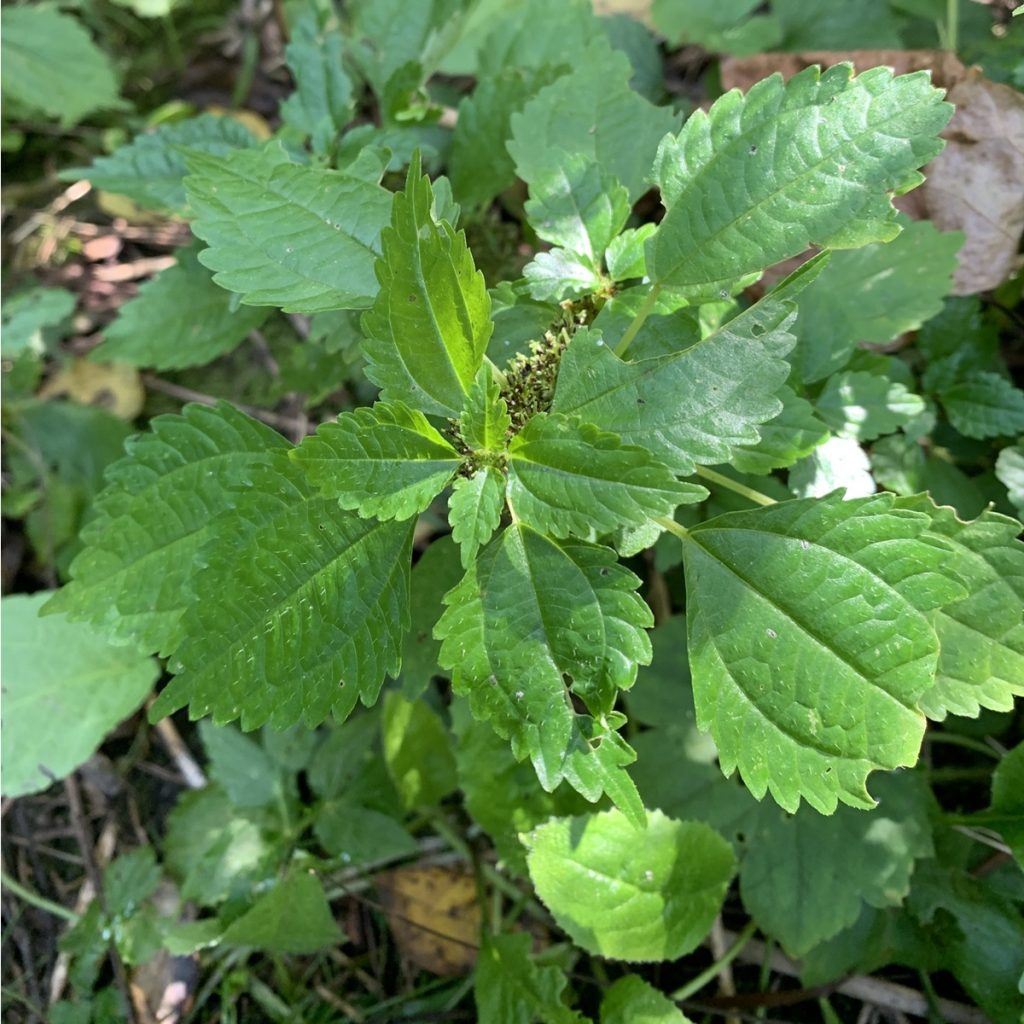
Now let’s look at another type of pilea plant – Pilea fontana. This herbaceous plant is native to moist woods and floodplains throughout most of North America east of the Rocky Mountains. It produces small flowers in late summer and can be distinguished from other pileas by its less ‘clear’ or translucent leaves and solid black, bumpy achenes. To ensure it thrives, Fontana care is essential: it needs plenty of bright light, regular watering, and occasional pruning. With proper care, this lesser clearweed will add beauty to your garden while providing you with peace of mind!
Pilea glaucophylla
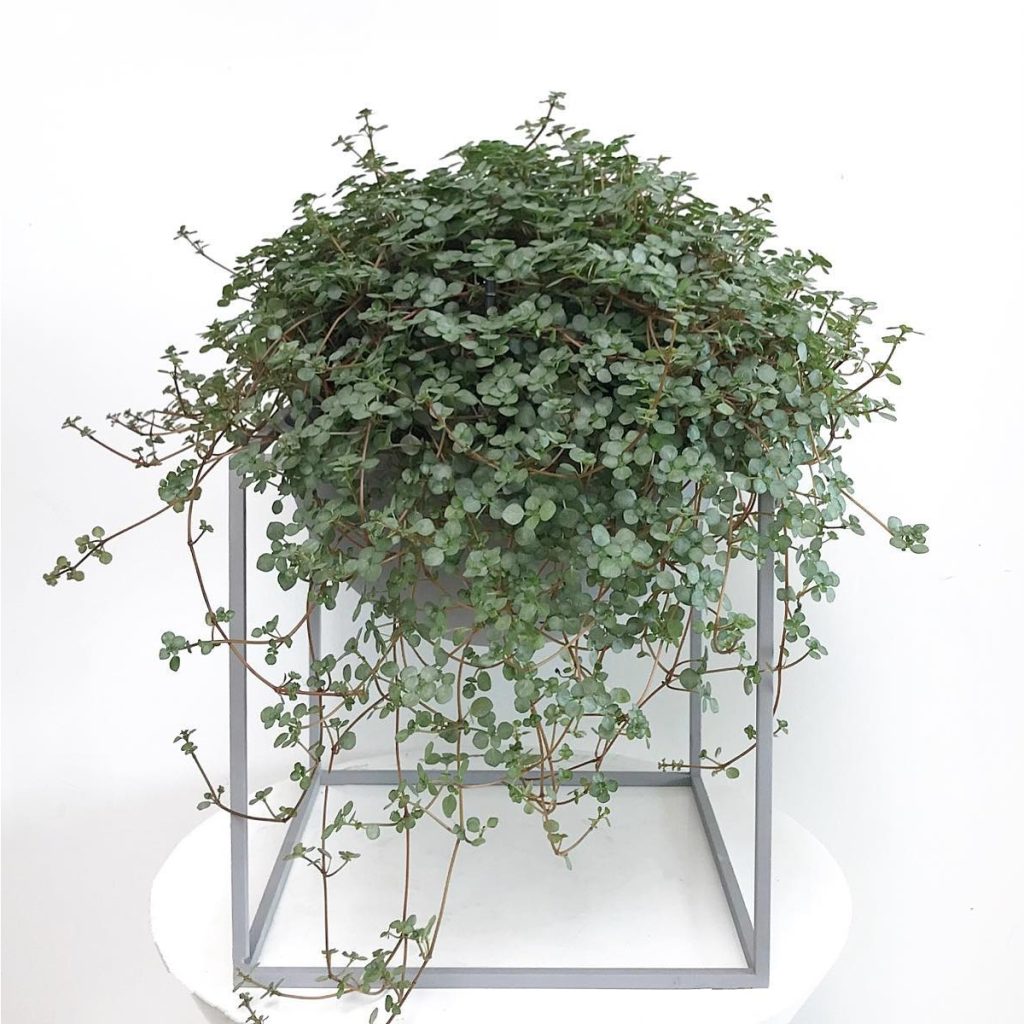
Pilea glaucophylla (Pilea glauca or Pilea libanensis), also known as Red Stemmed Pilea or Gray Artillery Plant, is a popular houseplant with silvery-blue round leaves and red trailing stems. It’s easy to care for and provides an attractive ground cover when kept short or can be hung over the side of its pot as a hanging plant if allowed to grow longer.
Plant care requires plenty of indirect sunlight, average humidity levels, and frequent watering with well-draining soil. Additionally, it’s important to protect the plant from cold temperatures so ensure it stays in a warm area indoors away from drafts. Pruning back any dead leaves or stems will help keep your Pilea glaucophylla looking its best and thriving.
Pilea grandifolia
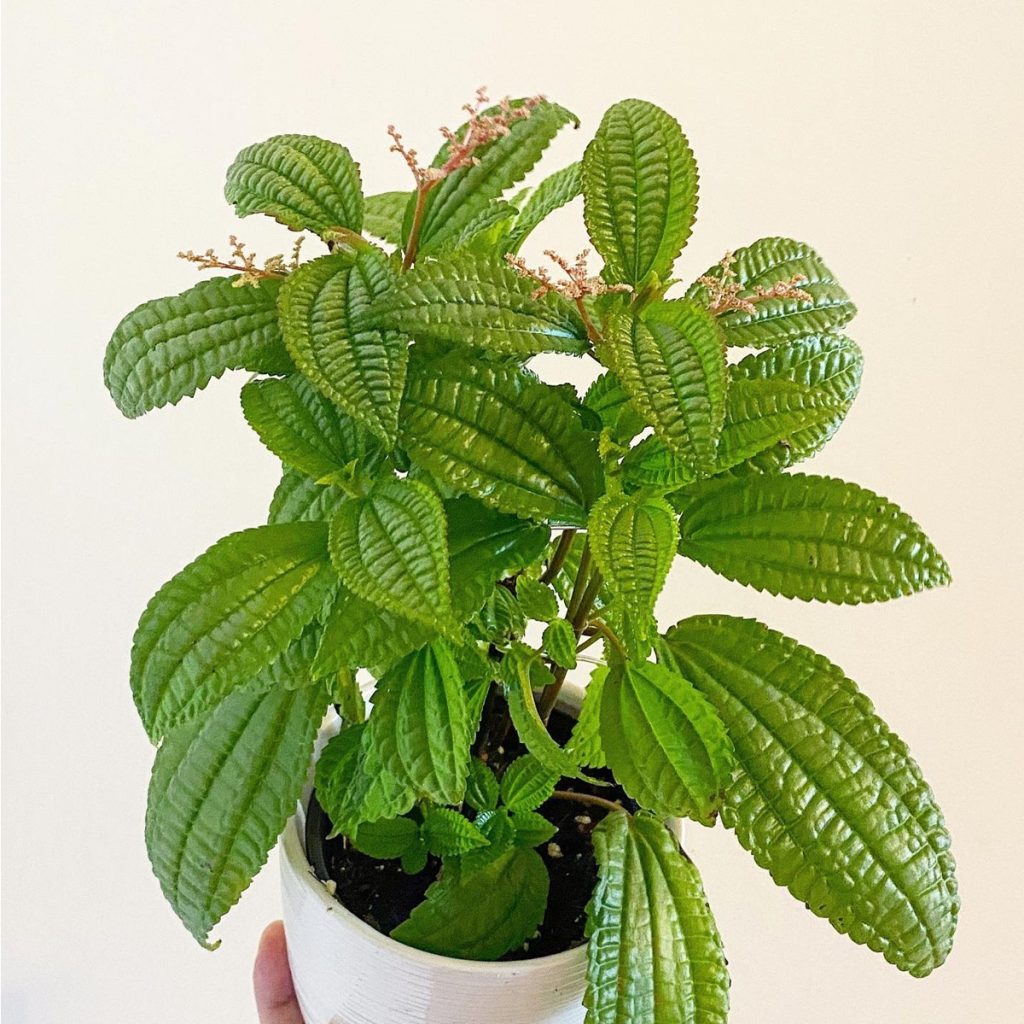
You’ll love the quilted texture of Pilea grandifolia’s oblong, apple-green leaves. This attractive species from Jamaica is easy to care for and fast-growing. It prefers shade to partial shade, with temperatures ranging from 45 to 95 degrees Fahrenheit. It typically grows up to 12-15 inches tall and should be kept slightly dry between waterings. Propagation methods include division or stem cuttings placed in moist soil; the cuttings will take root within a few weeks. The plant produces large clusters of interesting tiny flowers as well. Pilea grandifolia belongs to the Urticaceae family, so you can rest assured that it is safe for your home!
Pilea hyalina
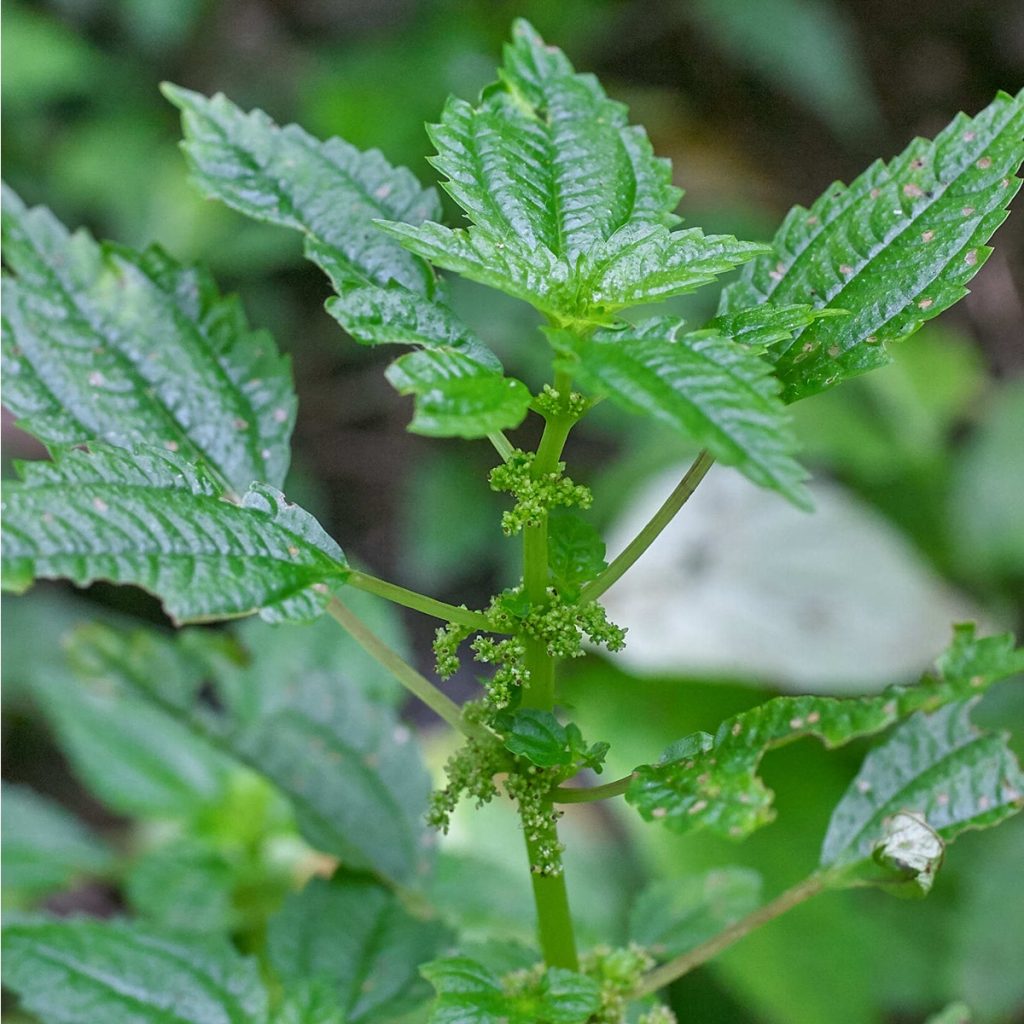
Enjoy the attractive, quilted leaves of Pilea hyalina – an easy-to-care-for species with unequal petioles and elliptic or elliptic-ovate leaves. This plant is a beautiful addition to any terrarium setup, and its care is simple. Its petioles are unequal in pairs, measuring 2–3.5 cm long, and are glabrous except near the leaf base on the abaxial surface. The leaves are elliptic or elliptic-ovate or ovate, sub-equal with a bluntly serrate apex that’s acute both above and below. Inflorescences come in two to four per node. To keep your Pilea hyalina healthy, make sure it has bright but indirect sunlight as well as even moisture levels throughout its growing season for optimal safety.
Pilea involucrata

This plant, commonly known as the friendship plant, is notable for its textured, deeply veined leaves and metallic colorations of bronze and silver. Pilea involucrata belongs to the family Urticaceae and is a perennial type of plant. It can reach up to 6-12 inches in height and width when mature. This low-maintenance houseplant prefers partial sun exposure and moist but well-drained soil with an acidic or neutral pH. During the spring months, it produces small pink flowers. It’s hardy in zones 11-12 in the USA, but also native to South America and Central America. Propagation methods include division or stem cuttings from established plants.
Pilea imparifolia
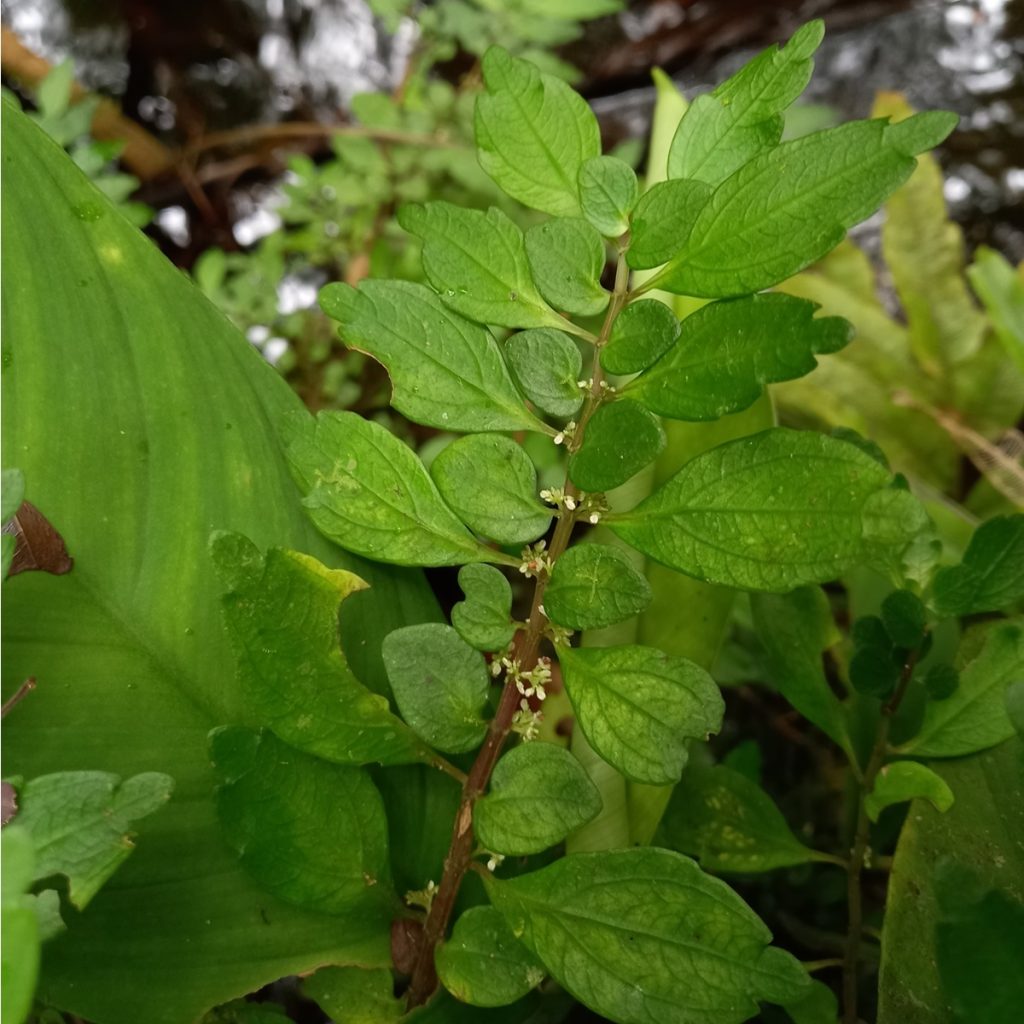
Pilea imparifolia is a pseudo-epiphytic herb with trailing to ascending stems and erect to ascending branches, usually monoecious. The stem is 1-3 mm thick and glabrous. Leaf pairs on the trailing stems are (sub)equal, but very unequal on the ascending stems and branches. Blades are papyraceous and glabrous. Inflorescences in the leaf axils contain 2-8 flowers.
Propagation methods of this species include division or cuttings taken in spring or summertime for best results. Cuttings should be taken from healthy parts of the plant that have not flowered yet, making sure to remove any excess foliage before planting them into moist soil or a rooting hormone can be used for better success rates.
Pilea japonica
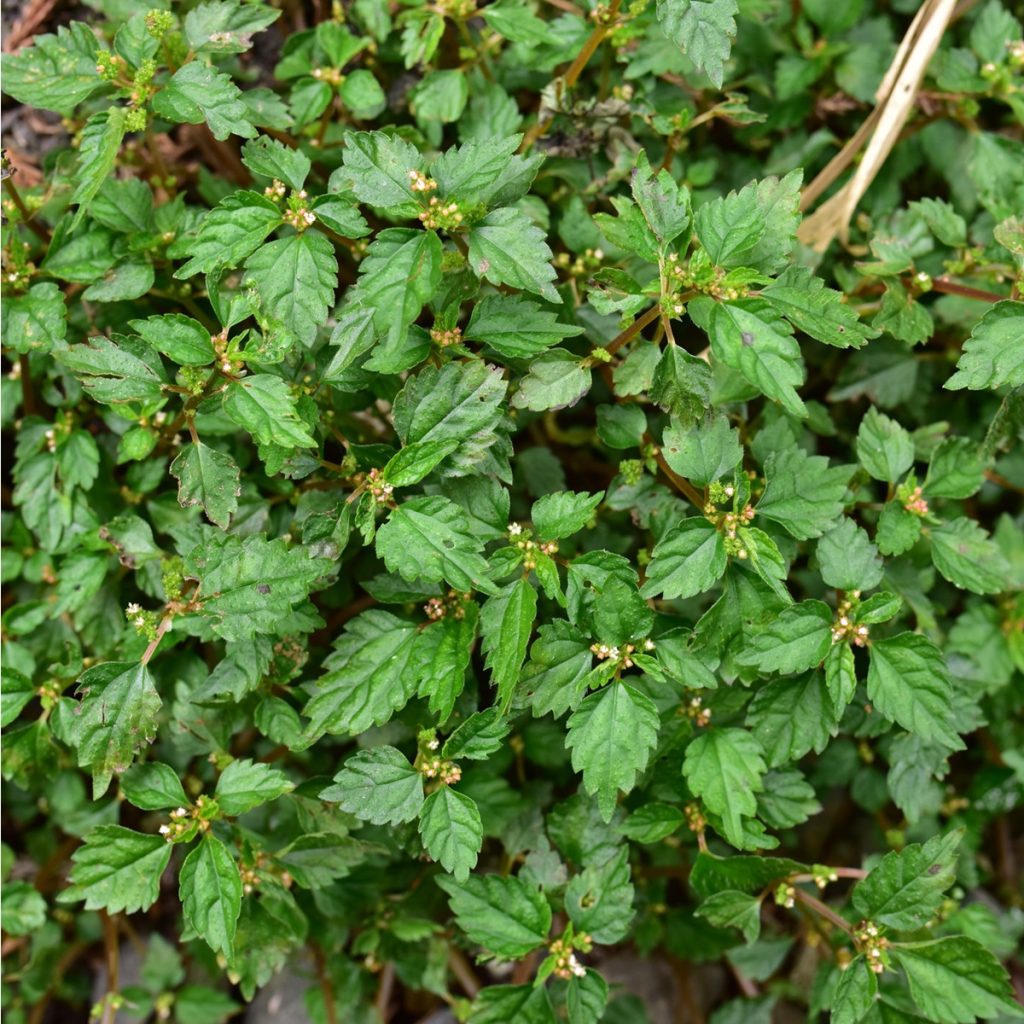
You’ll find Pilea japonica in damp, shady places in mountainous regions where it grows as an annual herb up to 20cm tall. Its stems are weak and tinge brown. Leaves are opposite with petioles, broadly ovate shape, 4-6cm long, and have coarse serrations on margins. The upper parts of the plant bear 2-3cm-long peduncles that produce dense light green flowers during September and October.
To ensure your Pilea japonica is healthy, proper plant care should be taken into account. Provide sufficient light and water it regularly to maintain its growth but make sure you don’t overwater it as this can cause root rot. Pruning is also important to keep the size under control. This will help the plant develop a bushier form which makes for better flowering.
Pilea matsudae
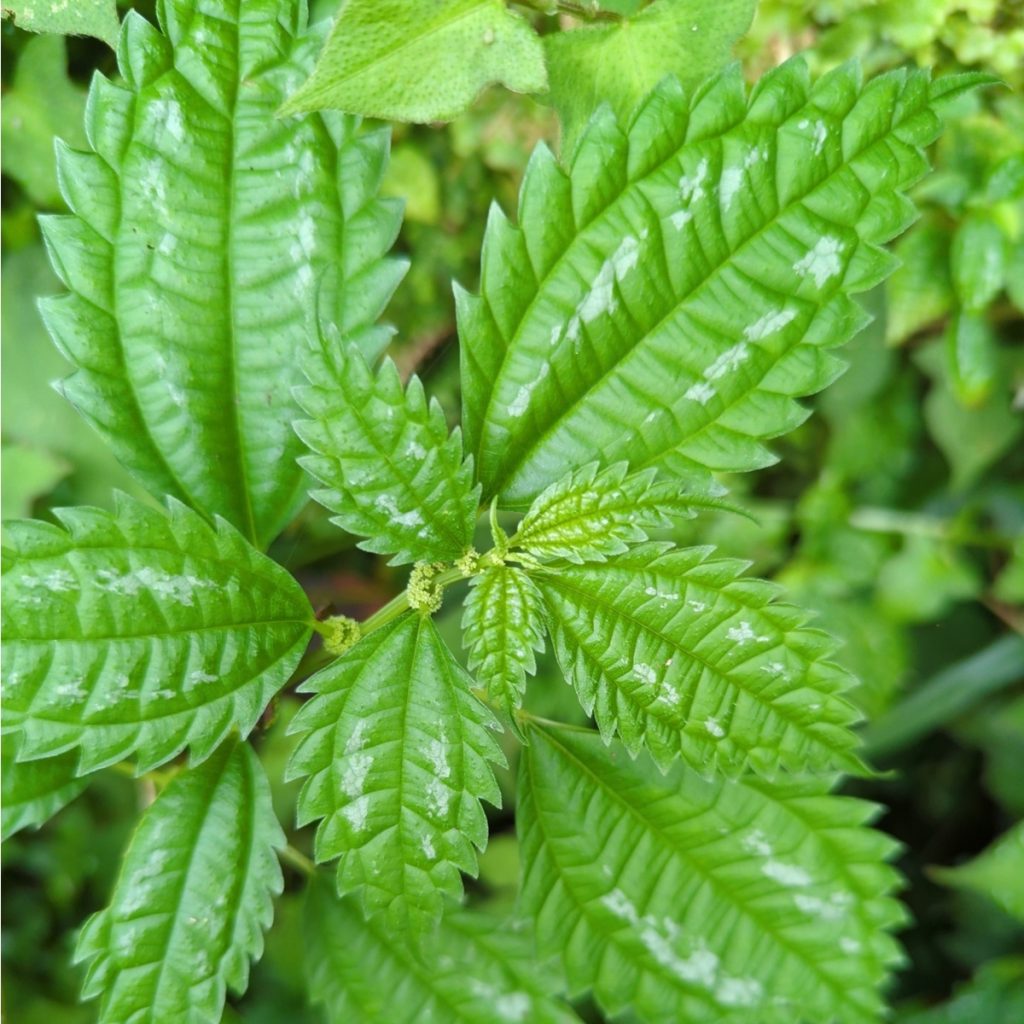
Pilea matsudae is a perennial herb with purple-red spots, growing up to 100 cm tall. This type of Pilea plant has stipules that are persistent and broadly triangular in shape. The leaves of Pilea matsudae are elliptic or elliptic-oblong in shape and have cystoliths that are worm-shaped. Plant care for this species includes regular pruning and fertilizing during the spring season. They should also be kept moist at all times and placed in indirect sunlight. It’s important to watch out for any signs of pests or diseases that may affect your plants as well. With proper care, you can ensure healthy growth for your Pilea matsudae plants!
Pilea melastomoides
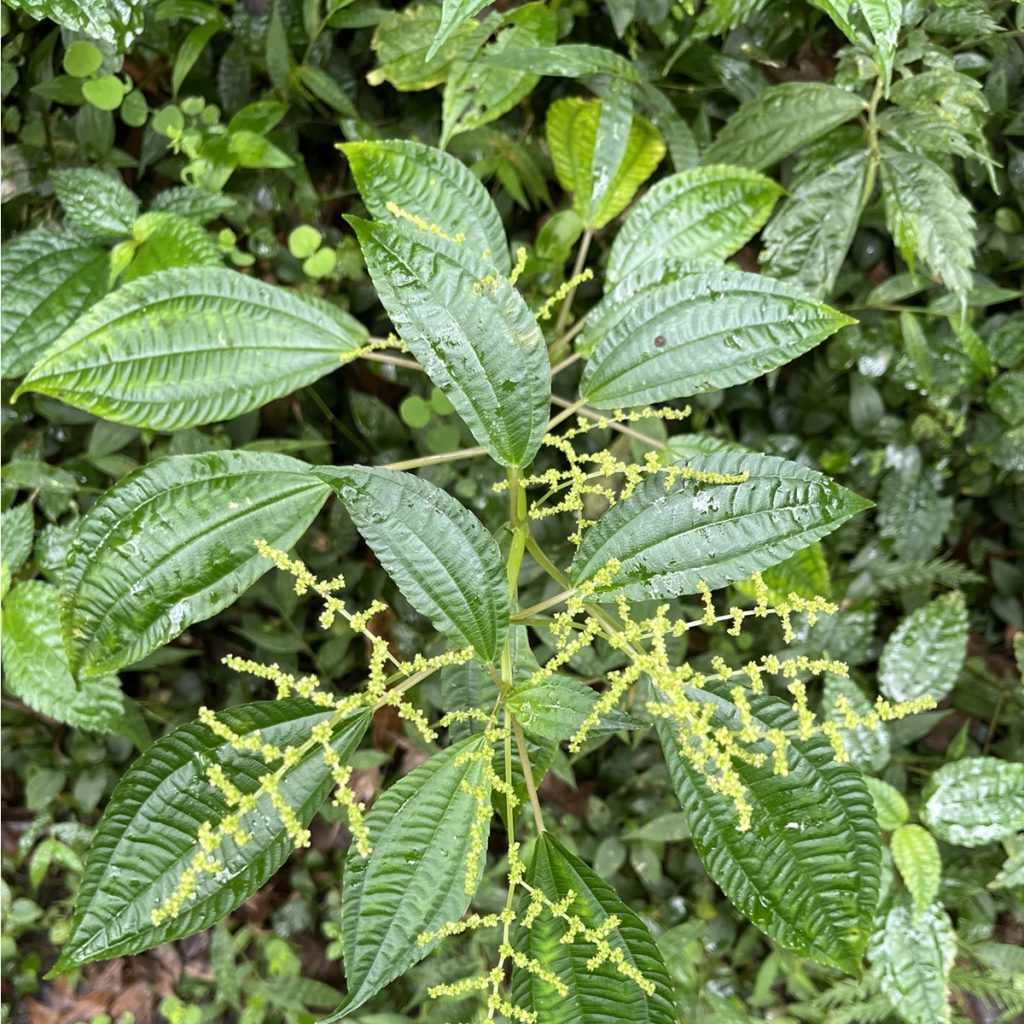
With its toothed, velvet-hairy leaves and small flowers, Pilea melastomoides is an attractive subshrub. It’s commonly found in South India and East Himalaya at altitudes of 700-1800 m. The male flower panicles are 10 cm across while the female flower panicles are 2 cm across. The tepals measure 4 mm for male flowers and 1 mm for female flowers while the seed pods measure 1 mm in diameter.
To propagate this plant, you can use stem cuttings which should be taken from healthy plants in late summer or early autumn. Ensure that your cutting has some roots or nodes before planting it in moist soil. Alternatively, you can also collect seeds when the pods turn brown and sow them directly into moist soil indoors immediately after collection.
Pilea microphylla
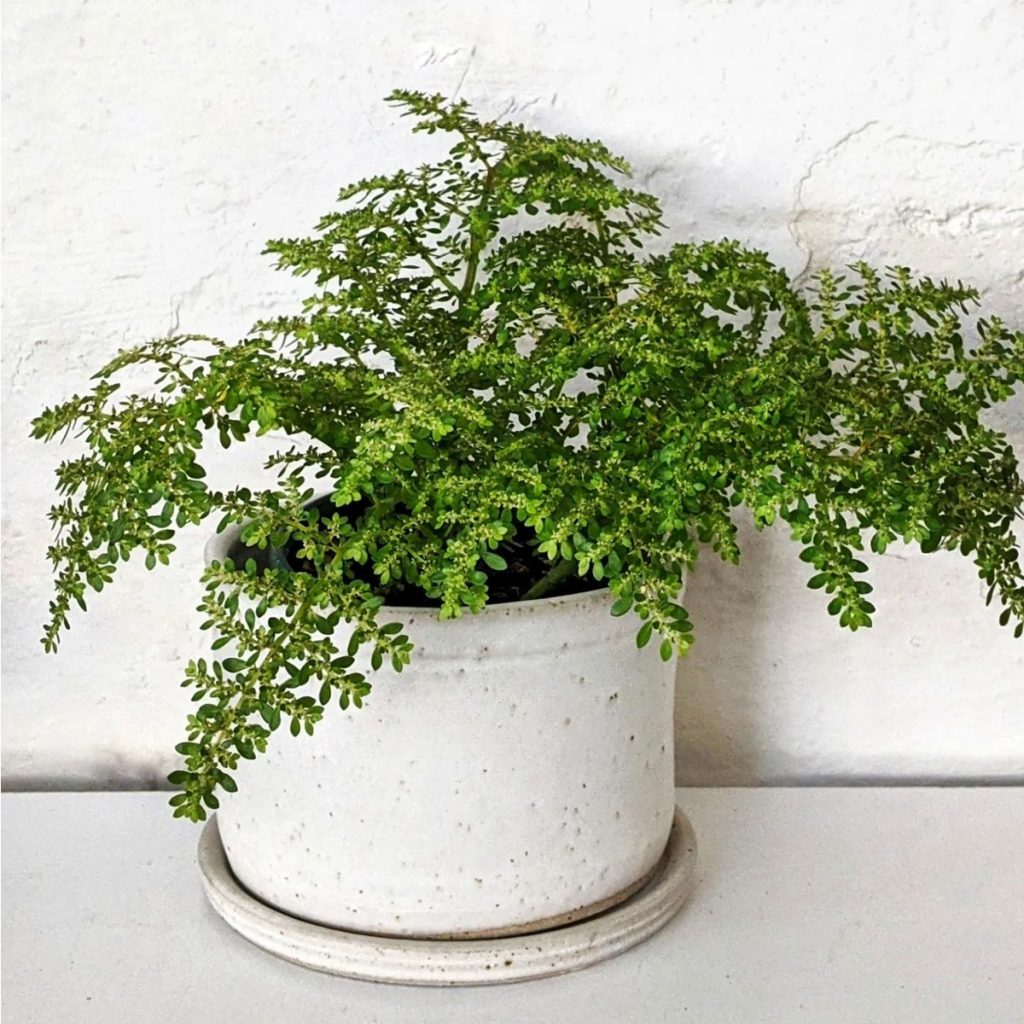
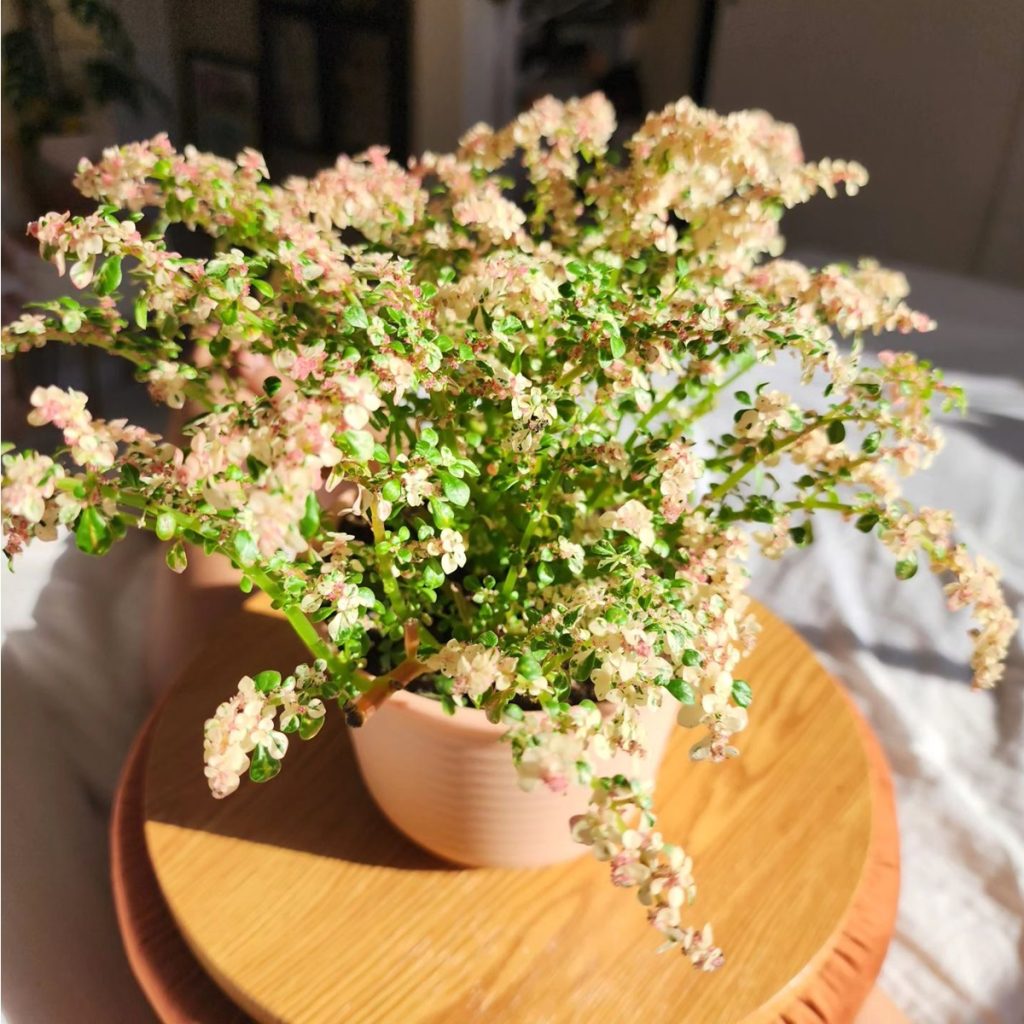
Artillery plant, also known as Pilea microphylla, is an annual or short-lived perennial with tiny green flowers that give it its unique name. It has many pairs of small, fleshy green leaves and can grow up to 12 inches tall and wide both indoors and outdoors. It is best suited for partial sunlight in moist but well-drained soil that is slightly acidic or neutral in pH. This makes it an ideal candidate for container gardening, as it does not require intense maintenance or a large amount of space.
Summer brings forth the yellow pollen burst from the tiny green flowers, often referred to as angeloweed or rockweed by some. The hardiness zone for this plant is 11-12 (USDA), so make sure you keep in mind its climate preferences when deciding where to place your artillery plant!
Pilea mollis
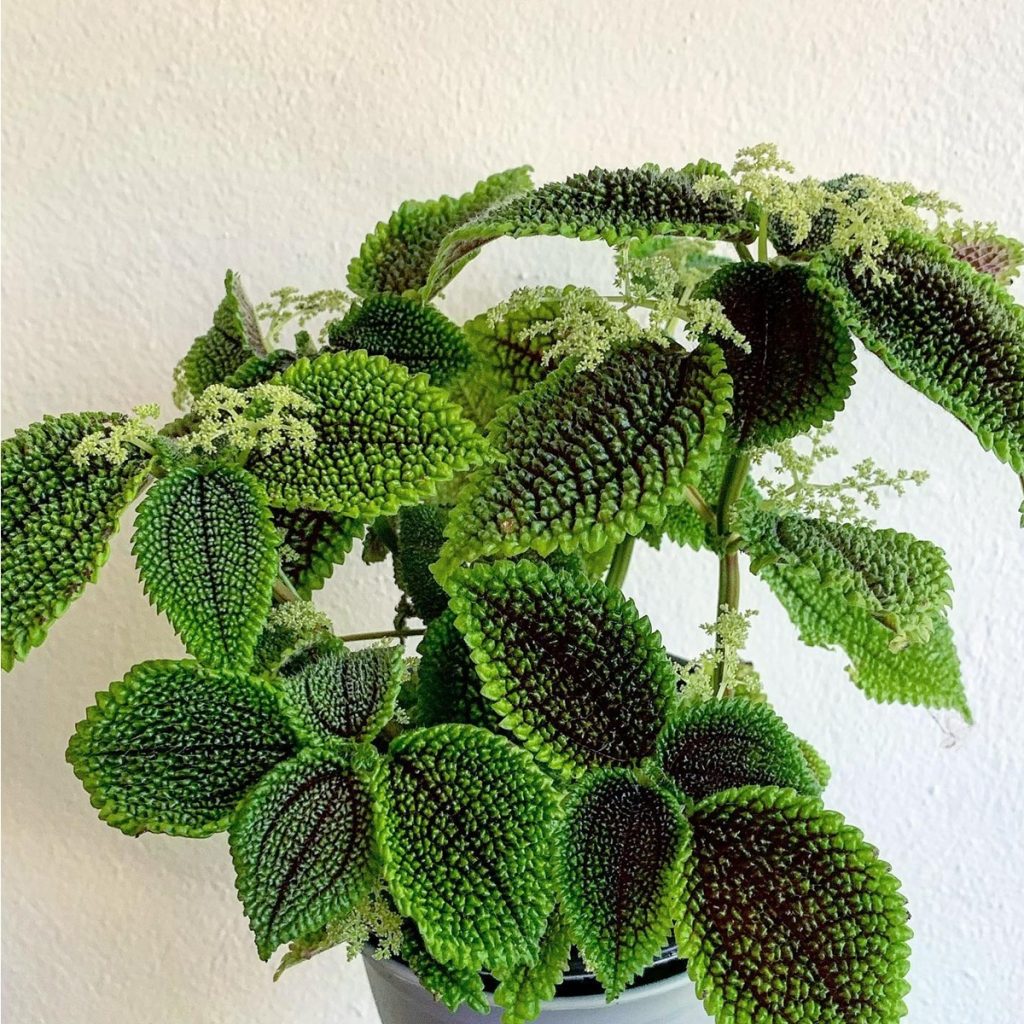
You’ll love the unique look of Pilea mollis, an evergreen perennial with velvety, light green leaves and white or pale-green-tinged flowers. Its plant care is relatively simple, making it a great choice for gardeners of all levels. To ensure the healthiest growth, choose a semi-shade location for your Pilea mollis and keep the soil moist but never soggy. Occasional misting will help too. Pinch off new stem tips to prevent legginess and feed plants on a regular basis using slow-release pellets or liquid fertilizers. Keep an eye out for sucking insects – they can be quickly remedied with safe pesticide treatments available at your local garden center.
Pilea notata
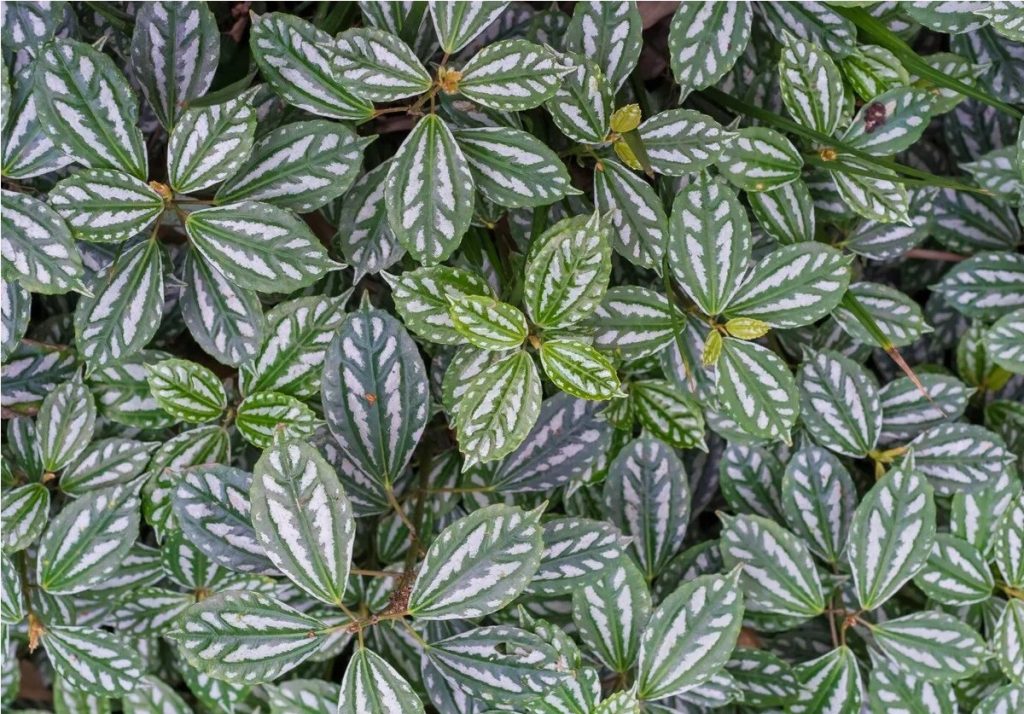
Pilea notata is a popular leaf-watching plant with its distinctive green and white leaves and can be used for indoor greening. It is a perennial herb that grows stolons, fleshy stems that are 25 to 70 cm tall, 2 to 4 mm thick and glabrous. Leaves are papery, ovate-lanceolate or ovoid in shape, dark green above and light green below. The flowers of this plant are dioecious and the fruit are small oval achenes with spiny verrucous points.
Pilea notata loves warm and humid climates, dislikes sun exposure, and needs water but can tolerate weak alkali soils. Plant propagation is easy with this species as it’s relatively cold-resistant – just keep temperatures above 6 degrees Celsius in winter for optimal growth.
Pilea nummulariifolia
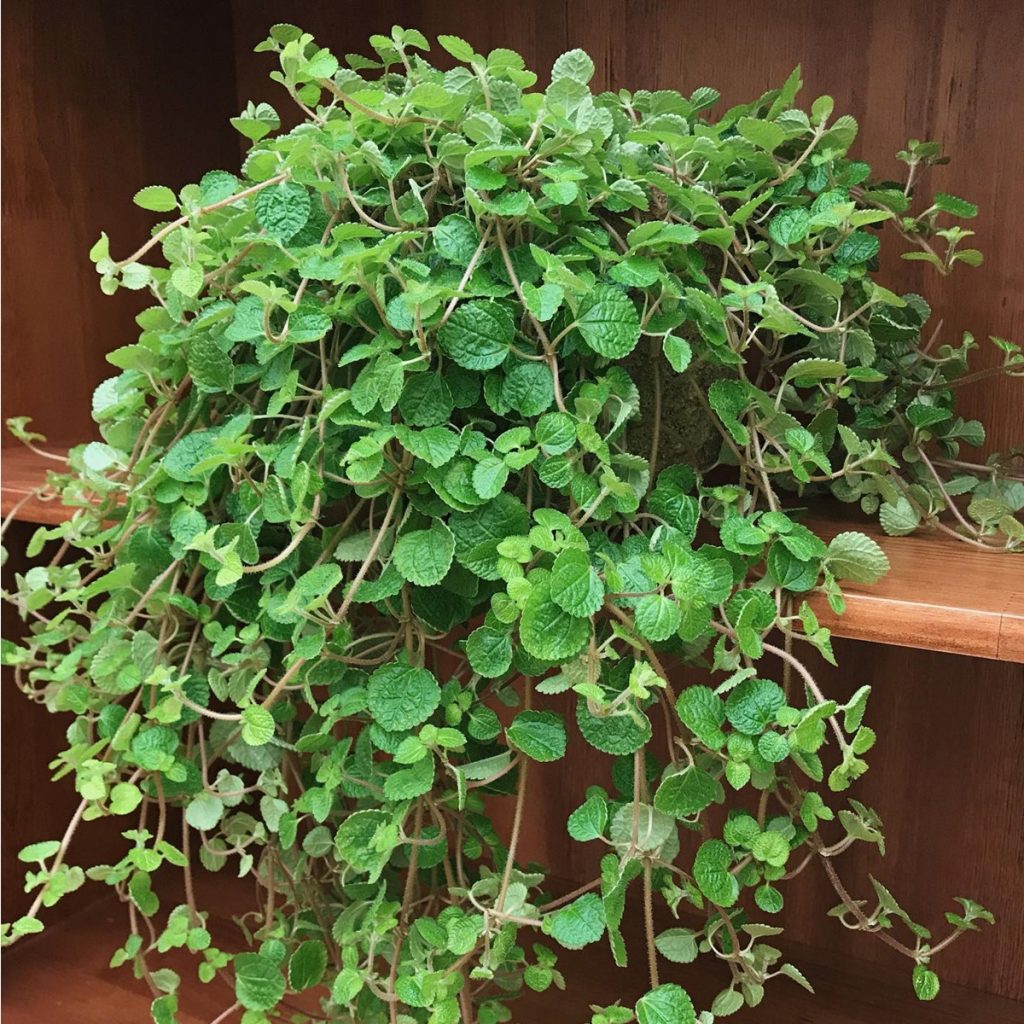
You’ll love Pilea nummulariifolia, a fast-growing perennial herb with deep green and silver-variegated leaves. It’s native to the West Indies to Peru and can be grown indoors or in shady outdoor areas. When it comes to plant care, this species prefers semi-shade and lots of water. Its growth rate is moderate to fast so it should thrive when provided the right environment. To maintain its vibrant foliage color, make sure you keep the soil consistently moist and avoid intense sun exposure as this will cause the leaves to burn. With proper care, your Pilea nummulariifolia will be a beautiful addition to any space!
Pilea peperomioides
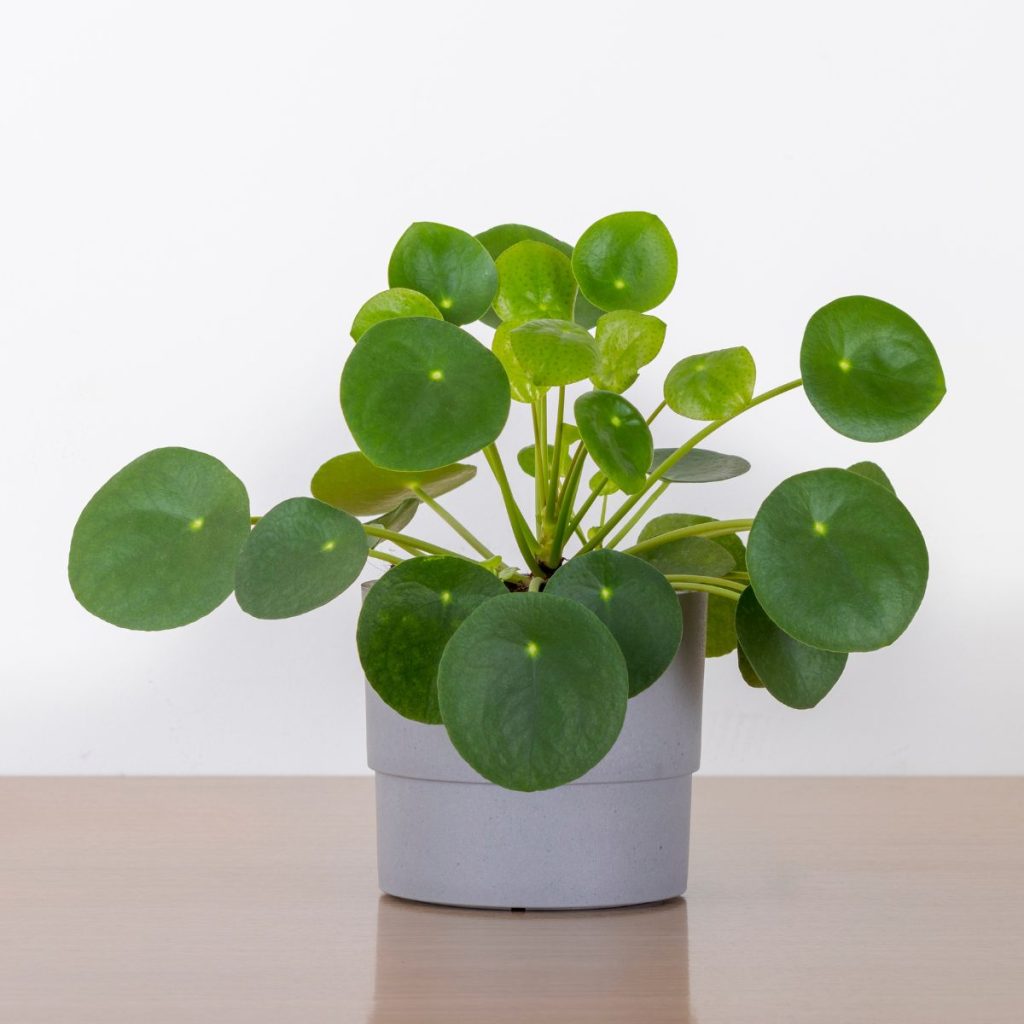
Often referred to as the pancake plant or Chinese money plant, Pilea peperomioides is a popular houseplant with attractive coin-shaped foliage and ease of care. This flowering perennial in the nettle family (Urticaceae) is native to southern China and grows naturally along the base of the Himalayan mountains.
The main attraction for this plant is its unique foliage; although it can produce small, white flowers during spring months, it usually doesn’t flower when grown indoors. To ensure your Pilea peperomioides thrives in your home, provide partial sun exposure and well-draining soil that’s slightly acidic or neutral. You can enjoy this beautiful houseplant for many years with proper indoor care!
Pilea peploides


You can find this pretty annual herb growing in damp places in forests, with its light green stems and small, orbicular-ovate leaves. Pilea peploides is a unique plant that stands out due to its three prominent veins on each leaf. Its light green male and female flowers mingle at leaf axils to form compact masses. It blooms from March to July, making it easy to recognize and propagate during these months.
Propagation methods for Pilea peploides can include seed sowing or stem cuttings for those looking for an easy way to expand their collection of this attractive plant. With the right care, you can enjoy this beautiful species all year round!
Pilea peltata var. peltata
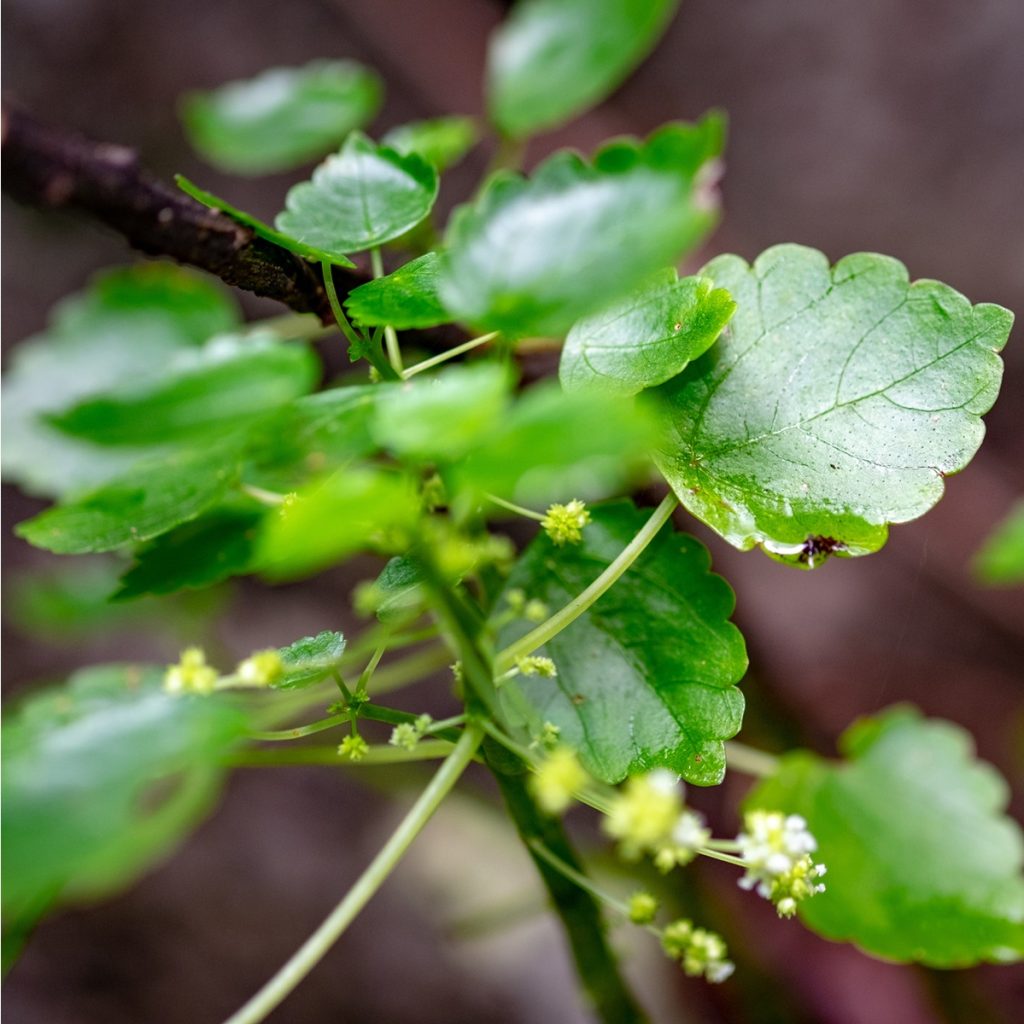
You can find Pilea peltata var. peltata in forests and thickets on limestone hills at elevations of 100-500 m. It grows on shaded, moist rocks, providing shelter for wildlife. Its leaf blade is cordate or suborbicular with a margin that’s shallowly undulate-crenate and an apex that’s acute or obtuse. In the summer months of June to August, it blooms and then produces fruit from August to September. This plant is a great addition to any garden due to its unique shape and beauty, while also providing a safe space for wildlife.
Pilea peltata var. ovatifolia
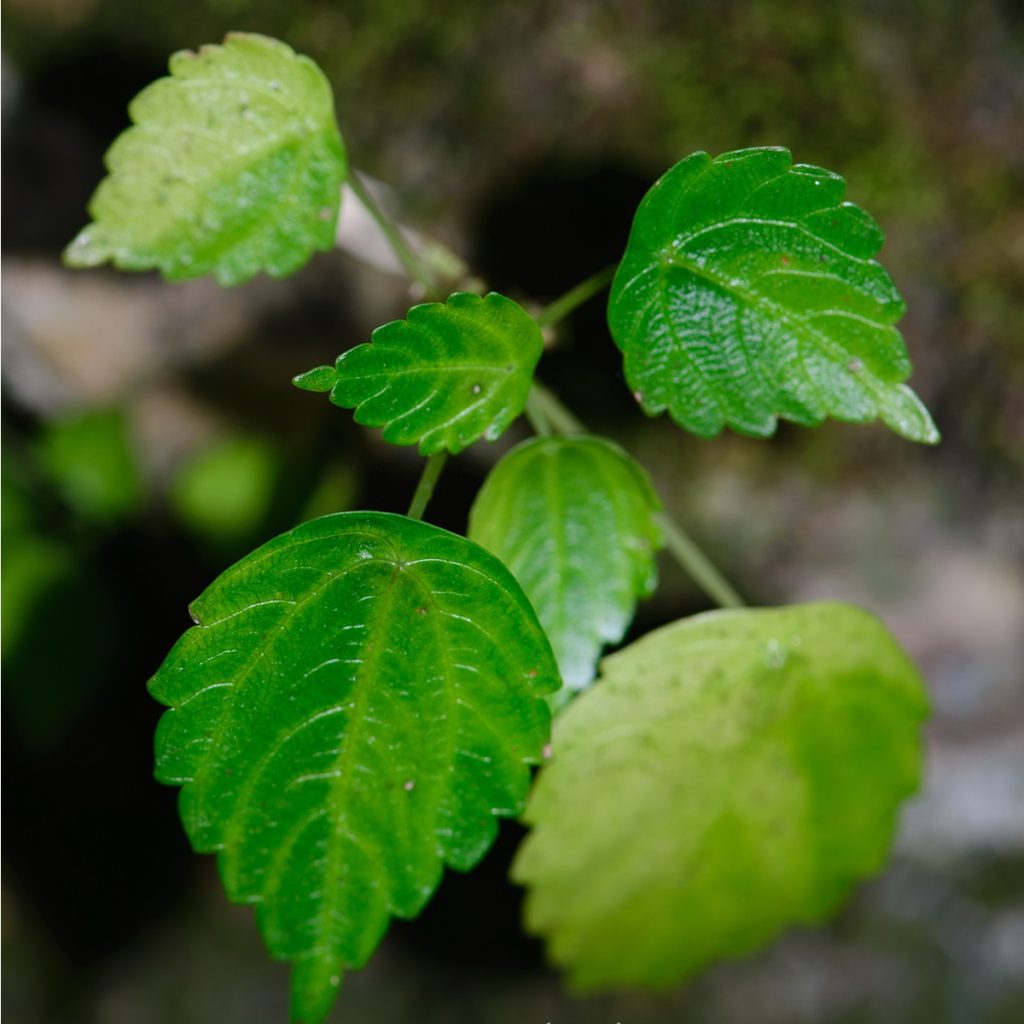
Pilea peltata var. ovatifolia has an ovate leaf blade with a sharply serrate or crenate-serrate margin and an acuminate apex. This plant is especially suited for shaded moist places in forests or thickets and can be found at altitudes of 300-400 m in Guangdong, China. It blooms from April to July and its fruits ripen from August to November, making it a great choice for any season. You’ll need to take special care to ensure the safety of your Pilea peltata var. ovatifolia by providing adequate moisture and shade while avoiding damaging temperatures or overwatering it.
Pilea plataniflora
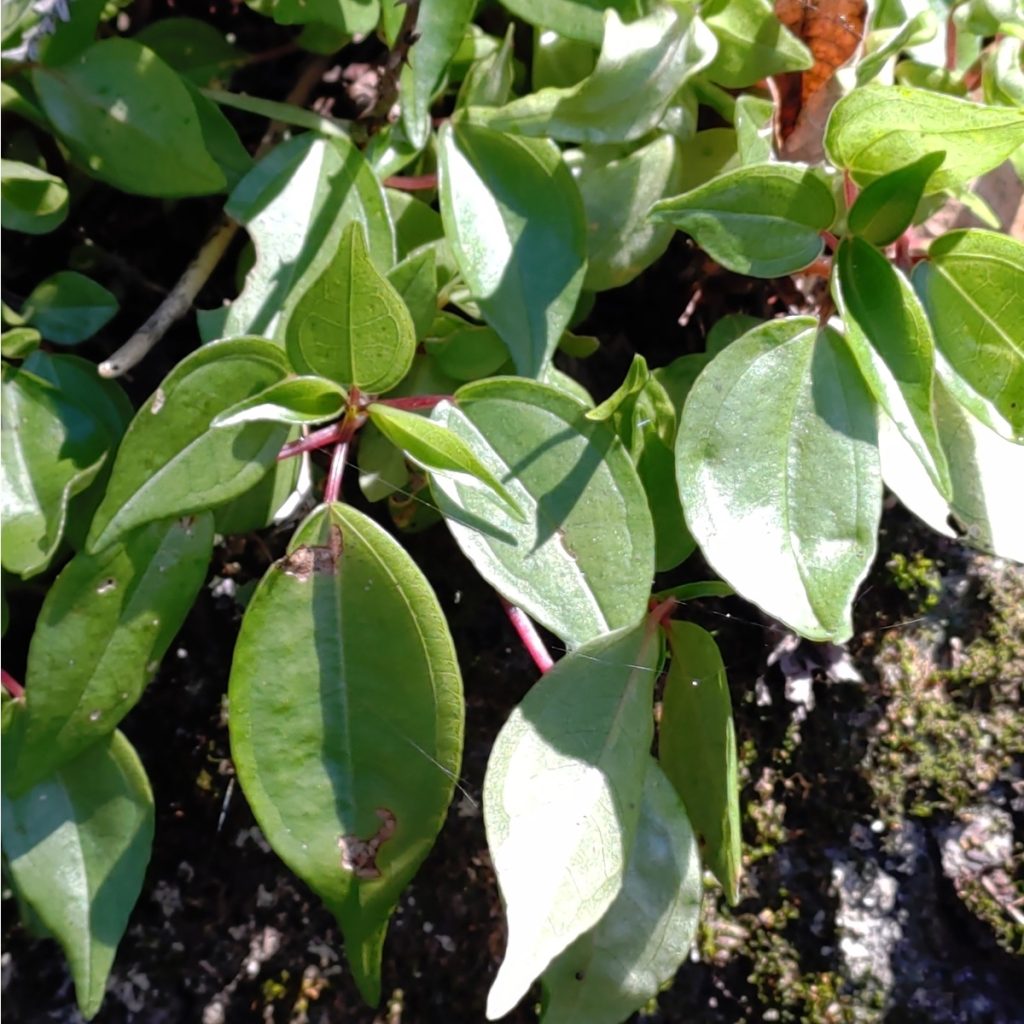
You’ll be delighted by Pilea plataniflora, an herb with long stolons and glabrous stems. It has dioecious or monoecious flowers, stipules that are gradually deciduous, triangular petioles, dark green or green-blue leaves and a cymose panicle or racemelike inflorescence when it is male. The female flowers have connate perianth lobes and three staminodes. This species is found in broad-leaved forests, semishaded wet places and near streams at elevations of 200 to 2400 meters. Its remarkable variability makes it quite an interesting specimen to observe in its natural habitat!
Pilea plataniflora ‘Glossy’
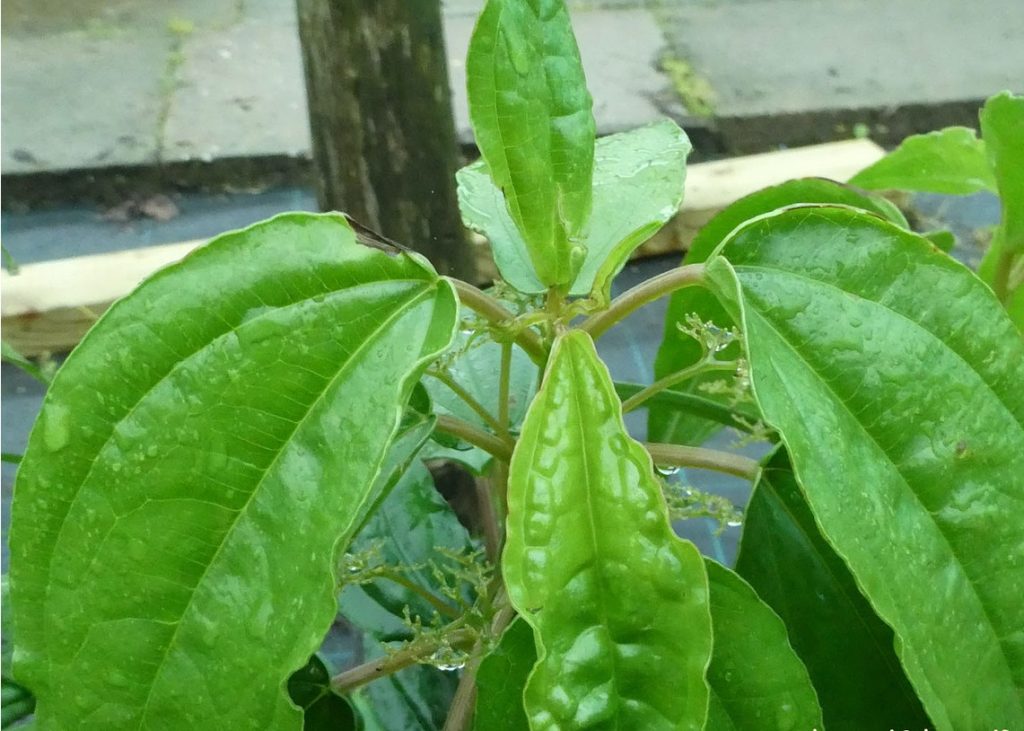
Experience the glossy foliage of Pilea plataniflora ‘Glossy’, a beautiful evergreen plant from Taiwan. This plant is part of the Urticaceae family, which doesn’t include the common Stinging Nettle. Reaching up to 50cm tall and with tiny white flowers held at its lead axils, this lush and exotic-looking hardy foliage plant looks great in any part-shaded position. It can even thrive in rich soil, so it’s an excellent choice for gardeners who want a safe yet eye-catching addition to their outdoor space. Whether you’re looking for beauty or safety, you’ll find it all with Pilea plataniflora ‘Glossy’.
Pilea pteridophylla
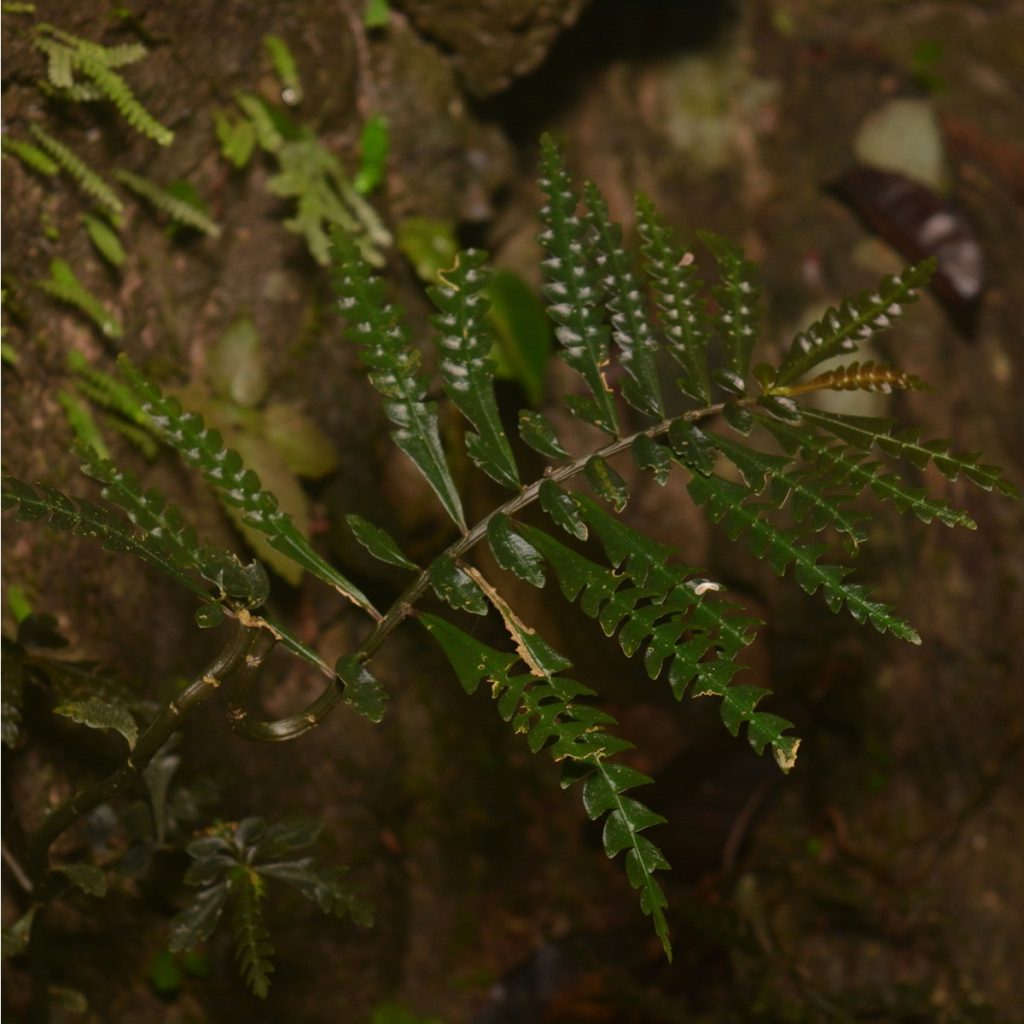
Discover the unique beauty of Pilea pteridophylla, an evergreen plant from the Dominican Republic. Found in Puerto Plata Prov. Sierra de Yaroa, facing the Yaroa Valley, this herbaceous plant stands 20 cm tall and has greenish flowers. It is found mostly on rocks near the top of limestone ridges, so it’s a great choice for those looking for a safe and sturdy way to bring some greenery into their home. With its bright color and hardy nature, Pilea pteridophylla is sure to be a favorite addition to any garden or living space.
Pilea pumila
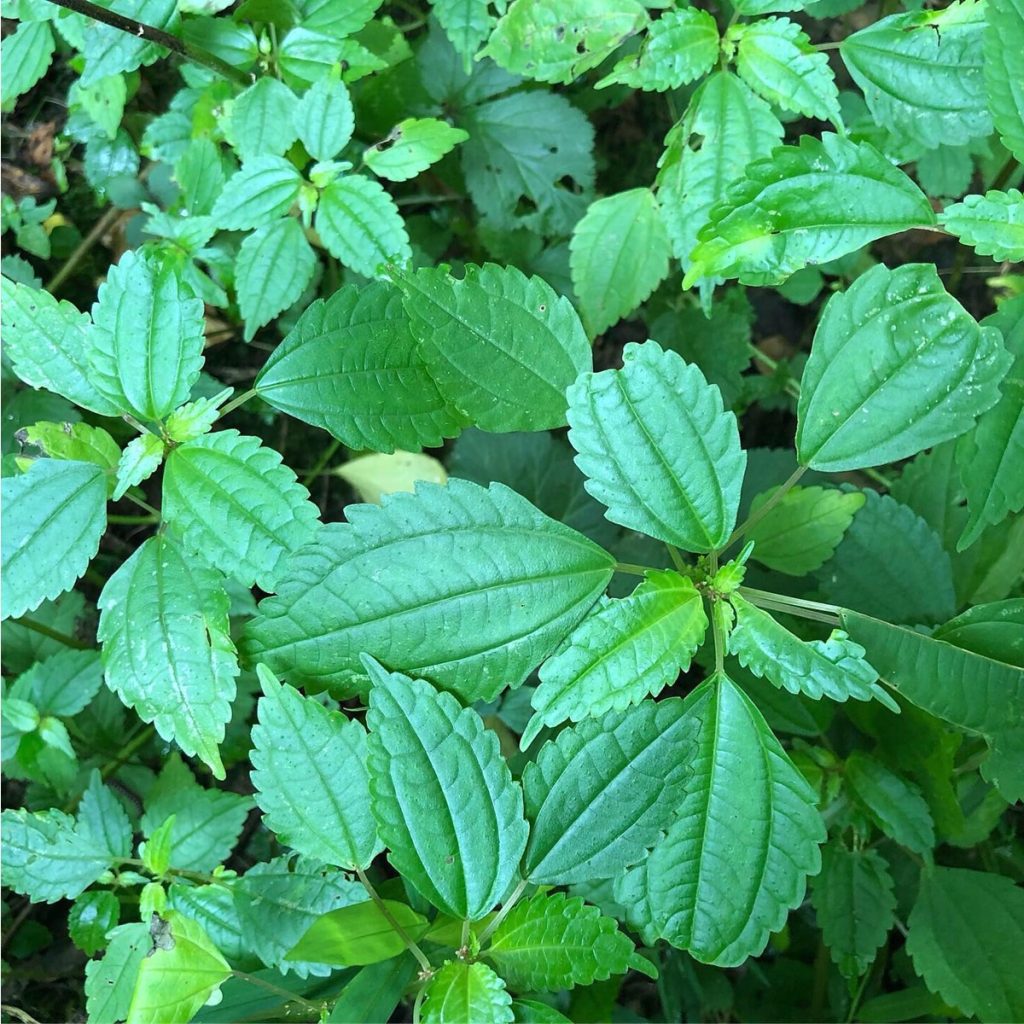
Now let’s move on to another type of pilea plant: Pilea pumila. This plant is native to Canada and typically grows in wetlands. It has simple leaves that are arranged opposite each other along the stem, and the edges of the leaves have teeth. The flowers of Pilea pumila are radially symmetrical, meaning they can be divided into two or more even parts.
Interestingly, Cherokee people used this plant for medical purposes; they would rub the stems between their toes to relieve itching, while Iroquois people inhaled liquid from the stems as a sinus remedy. So if you’re looking for a unique addition to your garden, consider planting some Pilea pumila – it’s not only beautiful but also offers potential medicinal benefits!
Pilea pubescens ‘Silver Cloud’
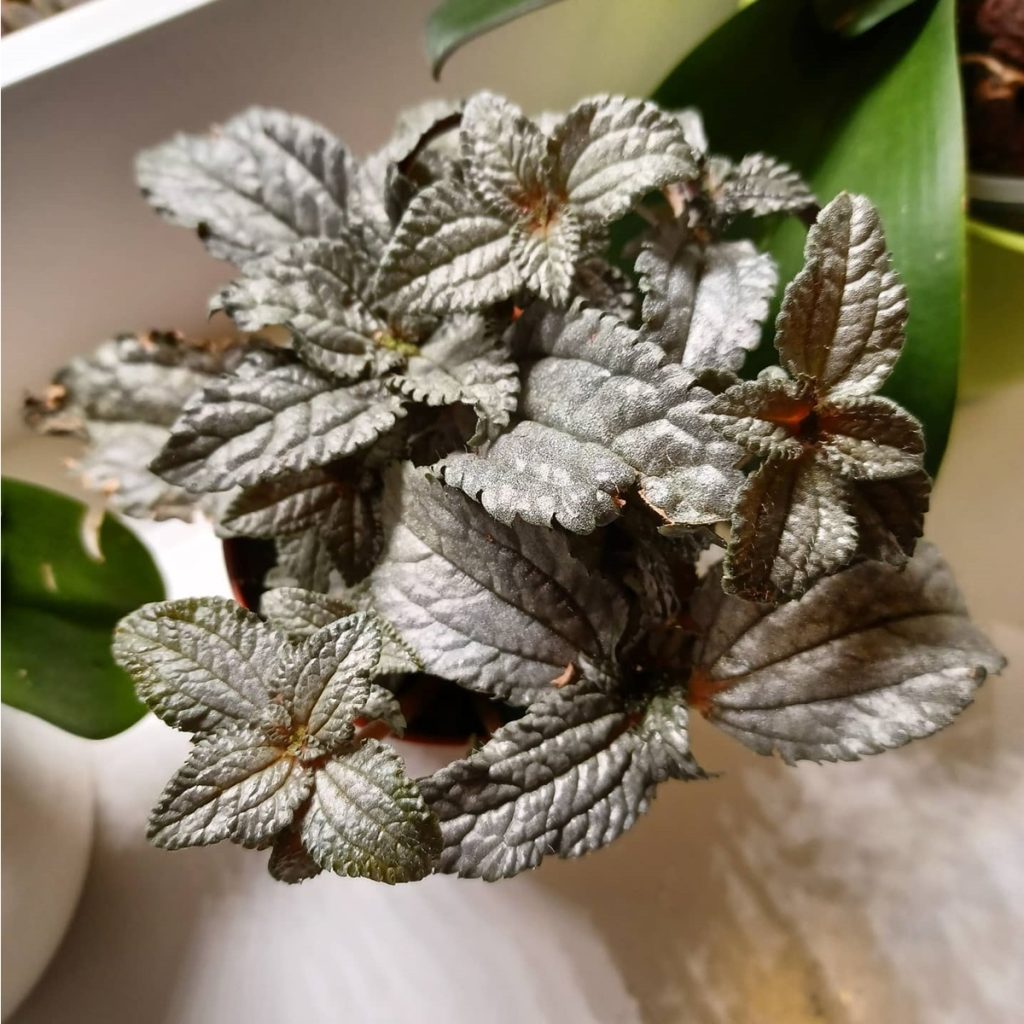
If you’re looking for a unique houseplant with striking silvery leaves, look no further than Pilea pubescens ‘Silver Cloud’! This upright compact plant grows to about 10 inches tall and has inconspicuous flowers. Its ruffled and serrated leaves have pinkish undersides, creating a beautiful contrast when planted alongside other silver or spotted begonias.
To keep your Silver Cloud in top condition, place it in bright conditions and provide regular humidity. Let the soil dry out slightly between watering, avoiding waterlogged soil. For outdoor placement, choose part to full shade and ensure temperatures don’t drop below 50F. In springtime, you may need to do some judicious pruning for new growth. With proper care, this South American native will thrive in your home!
Pilea rotundinucula
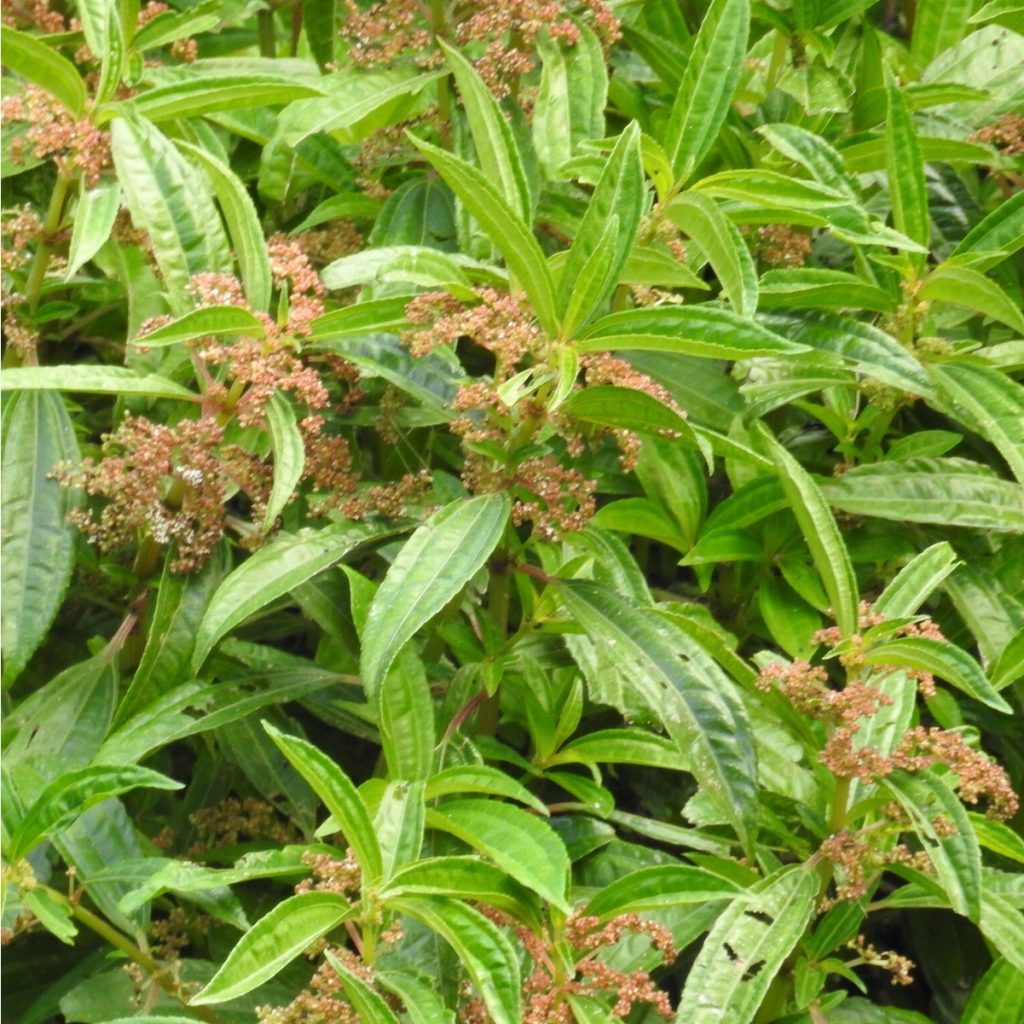
You’ll love the vibrant green foliage of Pilea rotundinucula, a rhizomatous perennial herb with glabrous stems and galls on its internodes. Growing up to 20-60 cm tall, it has triangular stipules around 1 mm in size and petioles that are usually equal in length. Its elliptic or oblong-lanceolate leaves have many lateral veins, transverse reticulate ones that are prominent abaxially, and serrulate margins. It produces male cymes 2.5-9 cm long with peduncles of 1-3.2 cm, while female flowers form clusters 0.6-3.5 cm long and subsessile buds about 1.2 mm long.
This low-maintenance plant can be found near streams, sunny roadsides or rocks in moist places between 300-1500 m elevation in Taiwan – enjoy its beauty today!
Pilea serpyllacea

Pilea serpyllacea is an herbaceous plant native to several South American countries and has been introduced elsewhere. It is a relatively small, low-growing plant with small, rounded leaves that can reach up to 1″ in diameter. This plant makes a great addition to any garden or home as it requires minimal care and grows quickly in moderate temperatures and humid environments.
Its growth habit makes it ideal for those who want quick coverage of an area without having to worry about invasive species taking over their yard. Pilea serpyllacea also produces tiny white flowers that make it a beautiful accent piece in any outdoor space. For best results, keep the soil slightly moist and provide the plants with plenty of sunlight.
Pilea serpyllacea ‘Globosa’
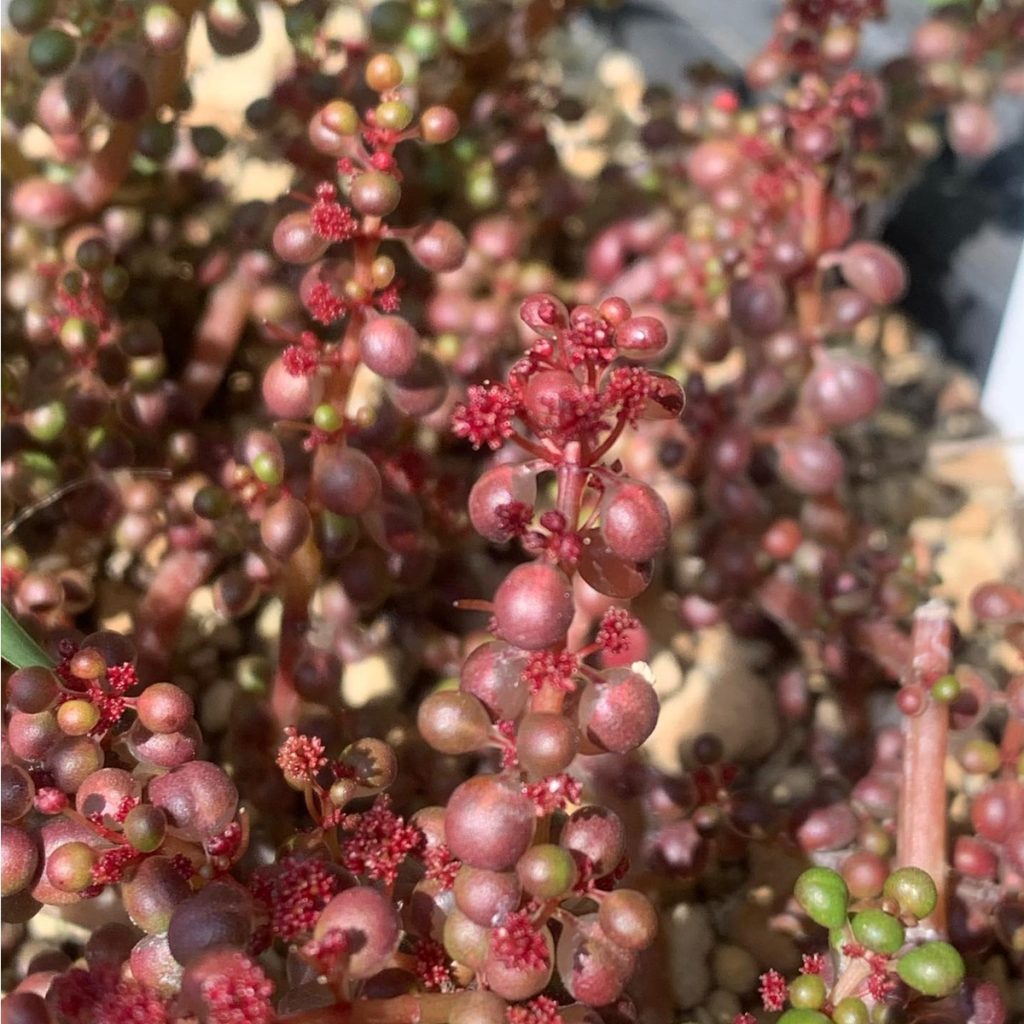
Pilea serpyllacea ‘Globosa’ is a semi-succulent plant with tiny, circular, green leaves and a trailing growth habit. It is native to Ecuador and Bolivia, and thrives in full sun, but needs protection from high heat. When grown under direct sun outdoors its leaves turn red and become plumper. For best results, prune regularly so that the plant grows fuller. This unusual plant should be watered often and kept in well-draining soil; fertilize monthly for optimal health. It also prefers indirect light or partial shade. You may see an occasional bloom of flowers, but the foliage is really what makes this plant special!
Pilea semidentata
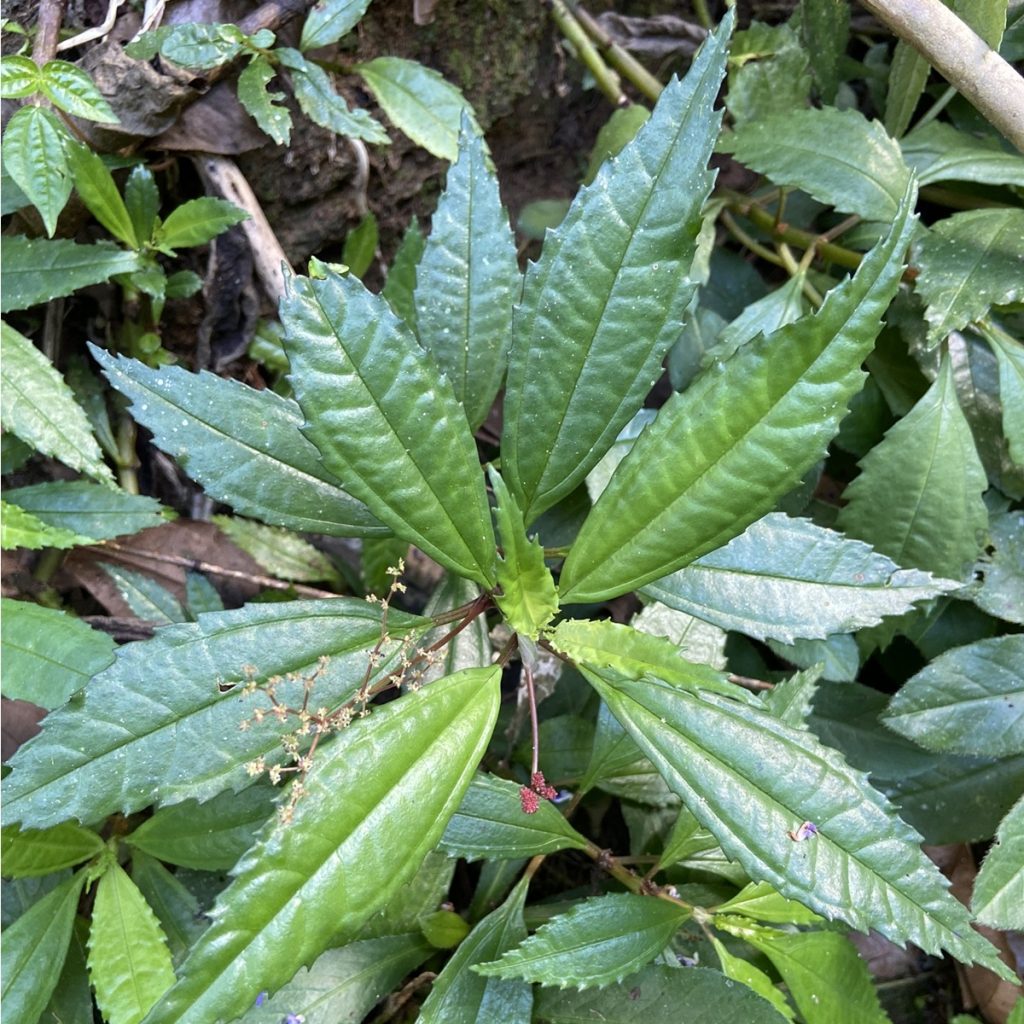
It’s a great choice for small spaces, as Pilea semidentata forms compact mounds of lance-shaped foliage and clusters of light pink flowers. This miniature species is perfect for terrariums or windowsill planters, as it won’t take up too much space and the foliage will provide lush greenery. The flowers that appear at the end of long peduncles are sure to add a splash of color to any home. Plus, this species is one of the few you can grow for its inflorescence! So if you’re looking for something to spruce up your indoor garden without taking up too much space, Pilea semidentata could be the right pick for you.
Pilea spruceana
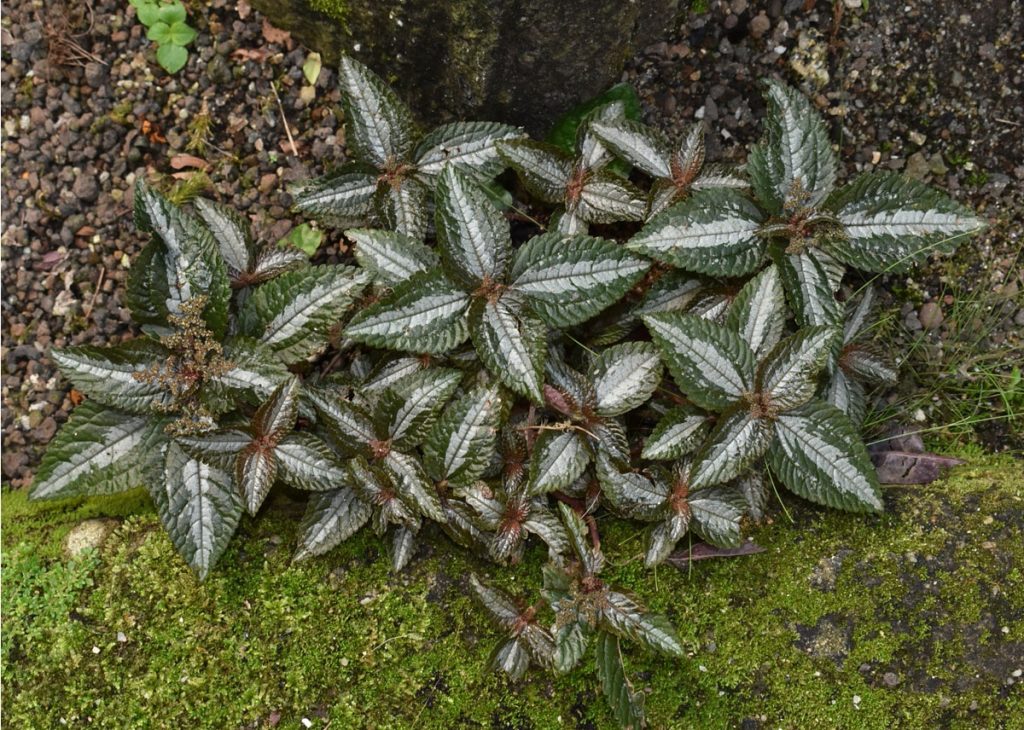
The next type of Pilea plant is the Pilea spruceana, also known as the Silver Tree. It’s an evergreen species that grows up to 1ft in height with a spread of 1.5ft. Its unique leaves are purple-brown and streaked with silver in the center, making it a great choice for adding color to your home. You can keep it in either an east-facing window or a lit terrarium for best results–just make sure you maintain high humidity and temperatures between 62-85F during the day and night. With some basic care, this beautiful houseplant will be with you for years to come!
Pilea spruceana ‘Norfolk’
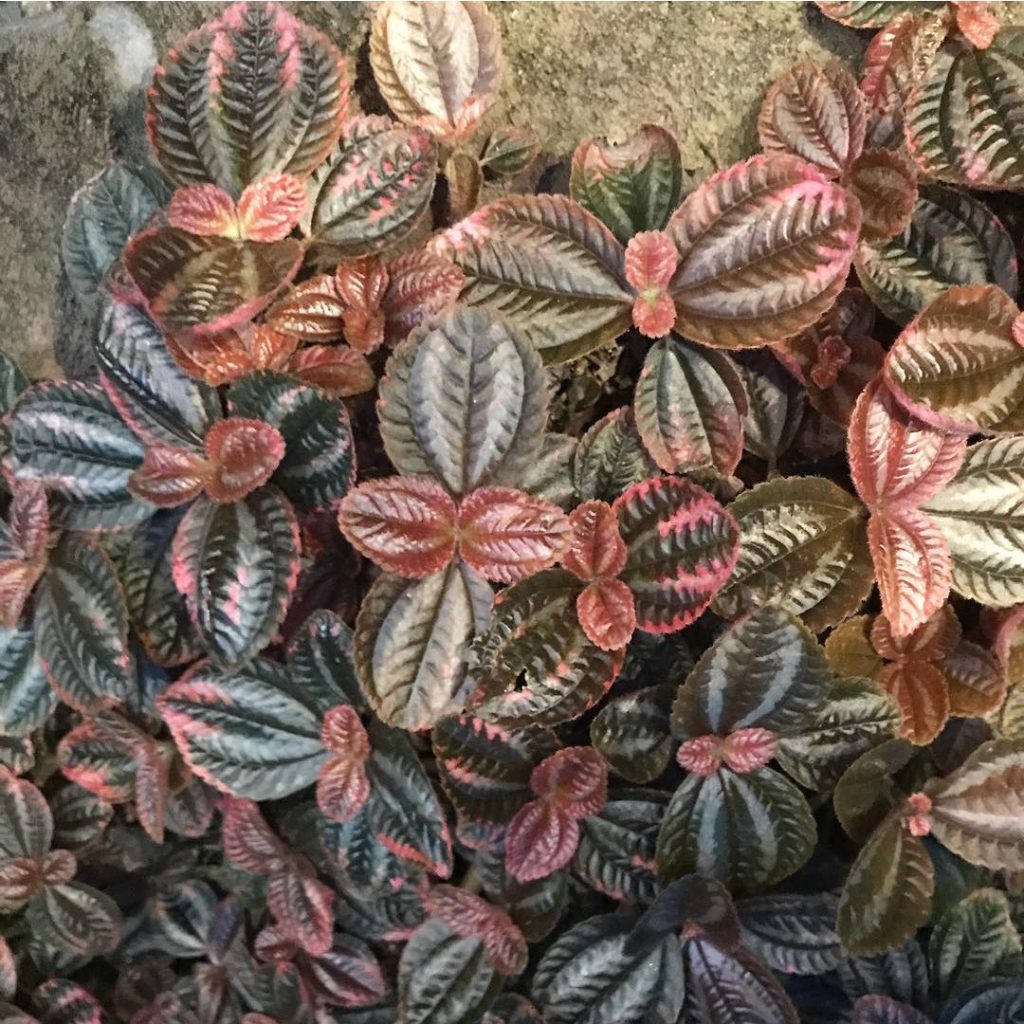
Pilea spruceana ‘Norfolk’ is a stunning evergreen species with its oval puckered leaves in bronzy red and pinkish shades, streaked with silver markings. You’ll be captivated by the dramatic silvery grey feathered markings and deep red undertones, as well as the sun-blushed pink leaf edge. This Peruvian native has a low-spreading growth habit and prefers to be kept slightly moist and in filtered light for optimal beauty. This Pilea may also be referred to as Angel Wings due to its unique winged shape. With proper care, this plant can bring an eye-catching beauty to any home or garden setting while providing safety from toxic plants.
Pilea swinglei
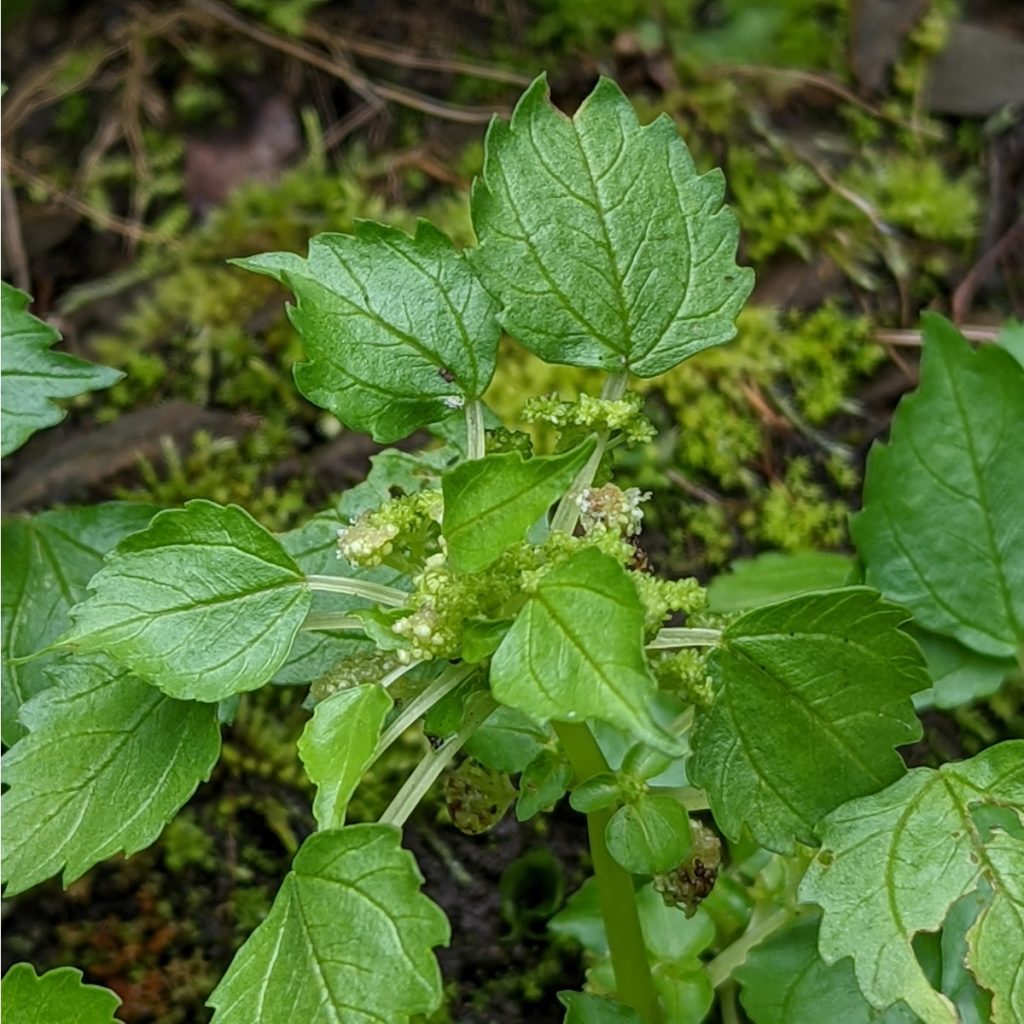
Transitioning from the previous subtopic, let’s talk about Pilea swinglei. It’s a plant of the genus Pilea and is found only in China. This plant grows in areas with an altitude of 400-1,500 meters like valleys, streams and damp rocks. Unfortunately, it hasn’t been found yet but you can cultivate it by artificial introduction. So if you’re looking to add some variety to your garden, this could be a great choice! Just remember to follow safety protocols when doing so.
Pilea tetraphylla
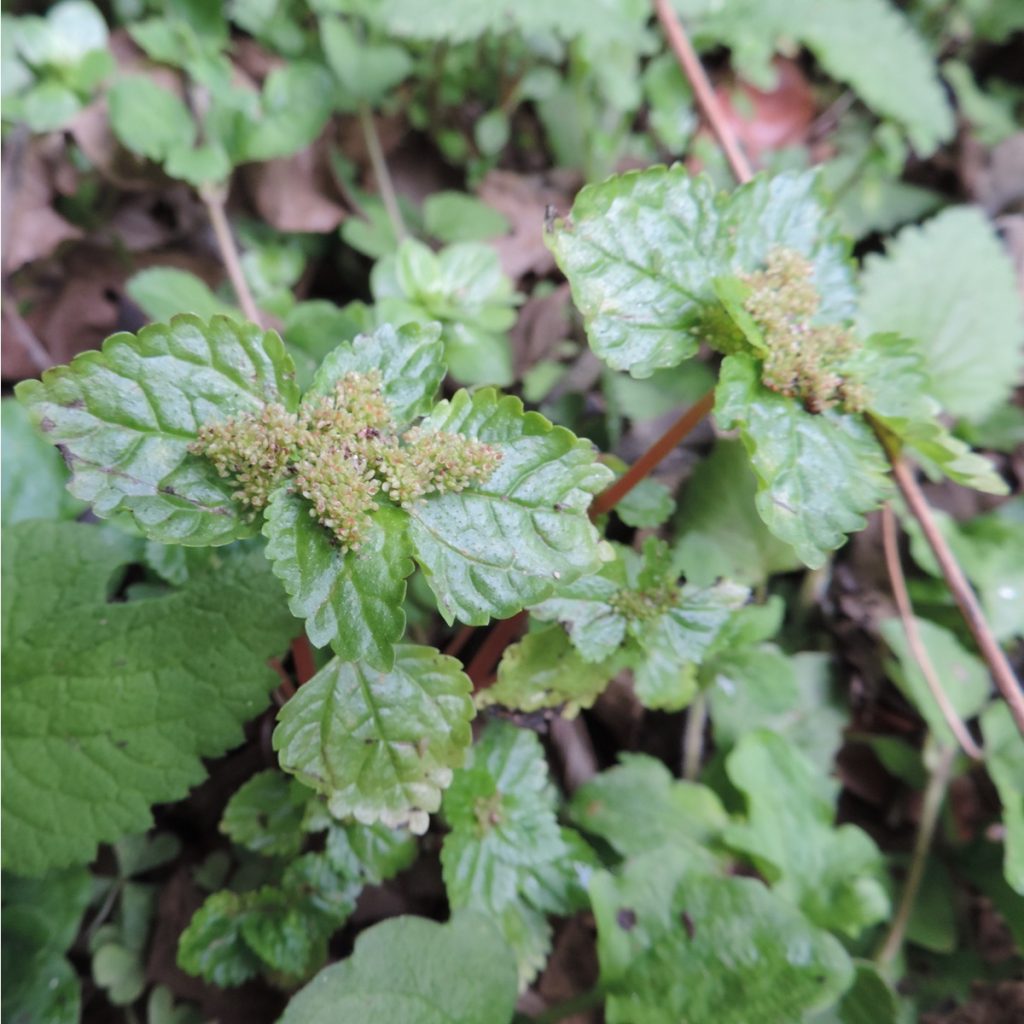
Pilea tetraphylla is a diœcious annual herb that grows up to 6 inches tall and produces densely crowded cymes axillary with 4-partite perianth. It has an erect or sometimes creeping stem, which is slender, simple or branched and glabrous. Its leaves form a pseudo-whorl at the apex of stems and branches. They are ovate, obtuse or acute in shape with a broadly cuneate base and margin that is somewhat grossly crenate-serrate above the base. Its petiole is almost filiform, shorter than the leaf.
The stipules are broad, rounded and persistent. Male flowers are densely crowded in the leaf axils while female cymes have one-sided cymules on short branches forming a densely paniculate spreading dorsiventral inflorescence with four upper leaves acting as an involucre. The achene is compressed-ovate, granulate and about 1/2 lin long for safe consumption.
Pilea tenerrima
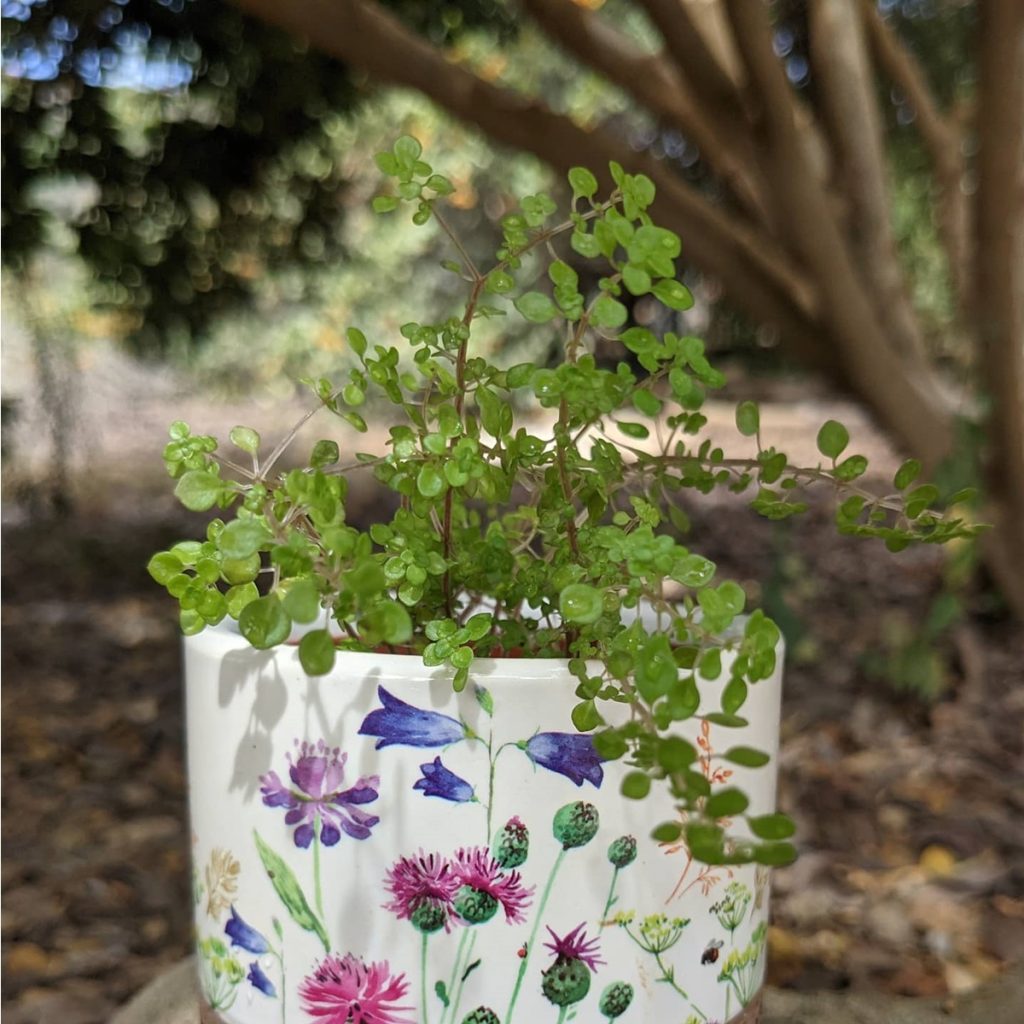
Pilea tenerrima is a mat-forming perennial herb that grows up to 15 cm tall and has tiny, whitish flowers. This type of plant has slender stems with a few reddish spots and obovate, ovate, or oblanceolate leaf blades. The blades are membranous, and glabrous, and have numerous transverse linear cystoliths on the upper side. Its lower surface features a conspicuous midvein and its base is cuneate, obtuse, or attenuate.
Flowers are greenish in color and appear in short axillary cymes. They have a perianth of 0.5-0.7 mm long for staminate flowers while pistillate flowers have one less than half as long. Finally, it produces ellipsoid achenes that measure around 0.5 mm long and are yellowish brown in color with a smooth surface texture for safety purposes.
Pilea tabularis
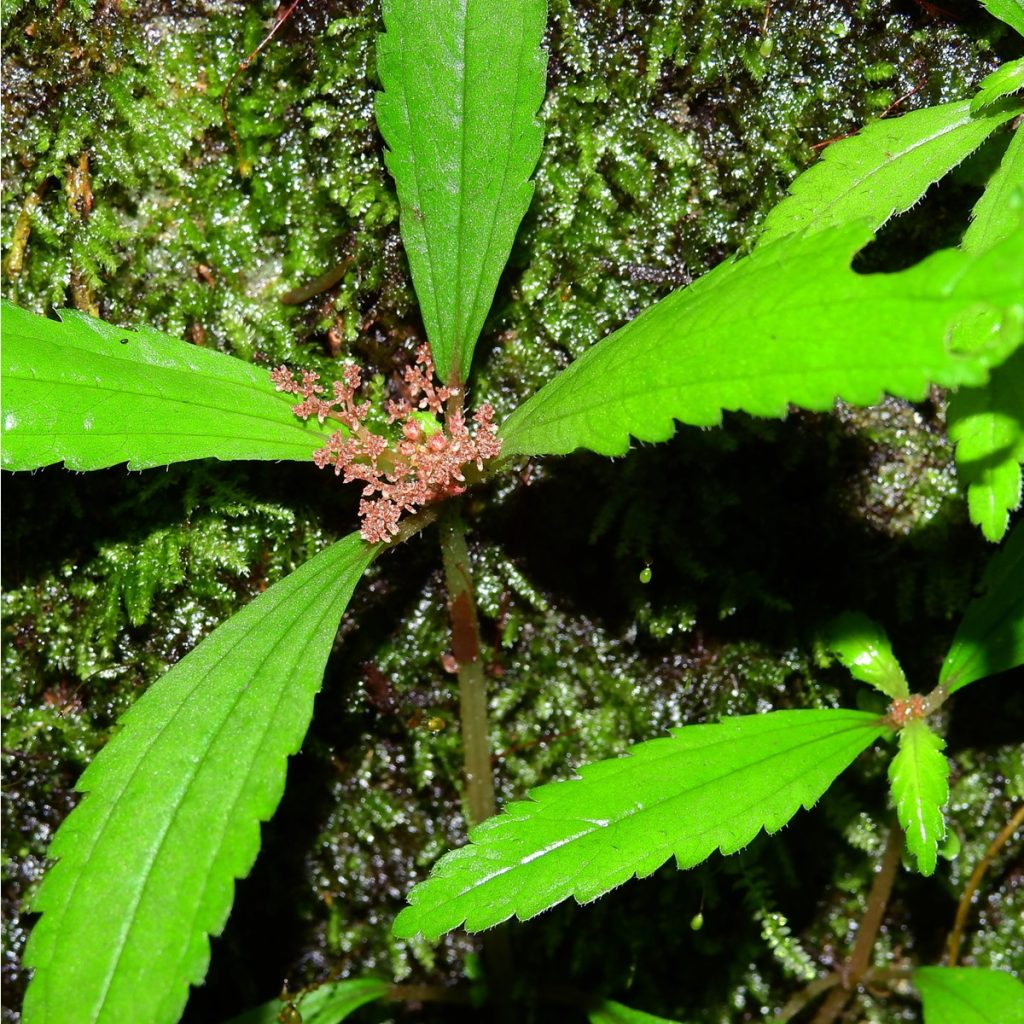
Pilea tabularis is a succulent, unbranched herb up to 50 cm high with narrow elliptic leaves and small flowers. The stem is glabrous or with sparse curved hairs and the leaves are arranged in pairs that can be equal or unequal. Stipules are 1.5-2.5 or ca. 10 mm long and both surfaces of the blade are glabrous. The inflorescences in leaf axils of staminate plants are 3.5-8 cm long and ca. 3-4 cm wide while those of pistillate plants are ca 2-3 cm long and ca 2 cm wide with peduncles of 1-1.5 cm long.
Pilea umbrosa
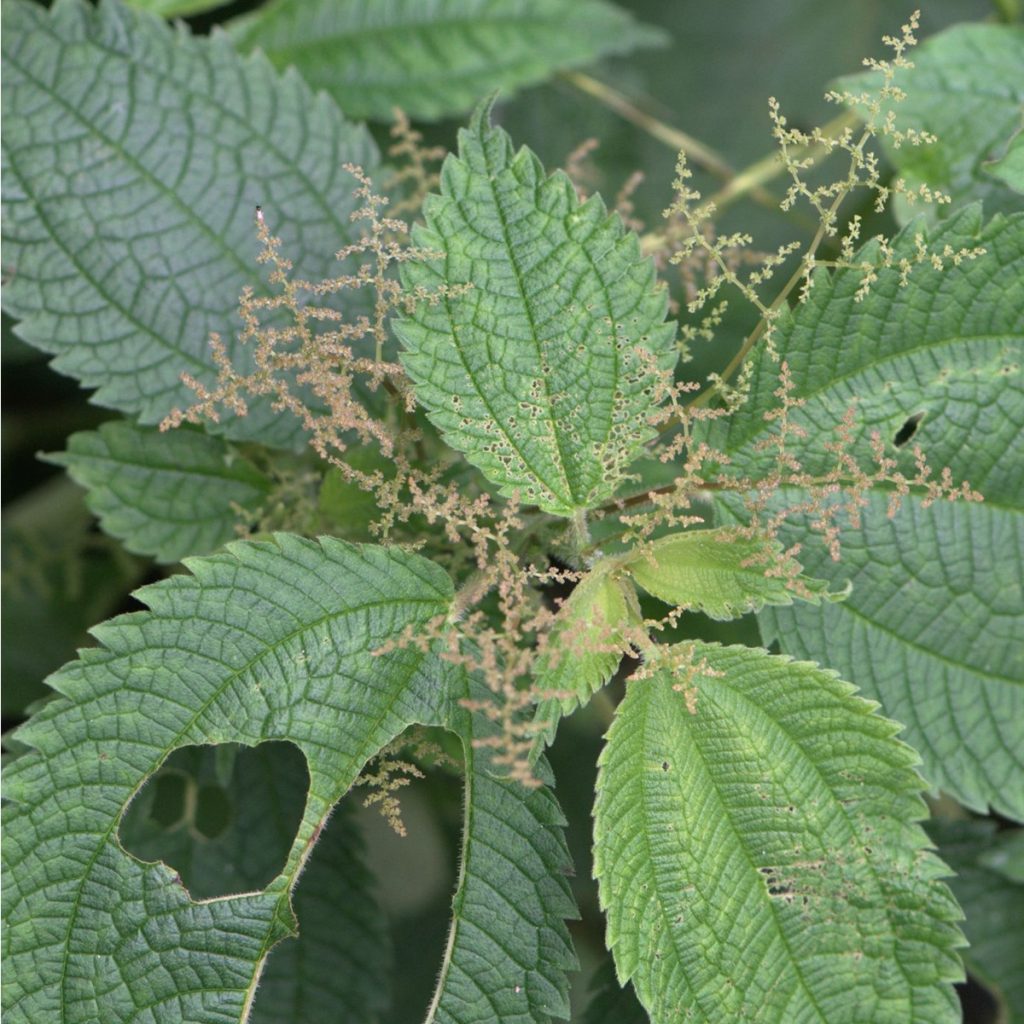
You’ll find Pilea umbrosa in the Himalayan forests, where it boasts erect stems covered with hairs and elliptic-ovate or oblong leaves. This plant is a perennial that’s usually 40-150 cm tall, with a leaf blade featuring three prominent nerves. Its flowers are tiny and greenish-white, pinkish or purple. Male flowers grow in clusters 10-15 cm long while female ones are 6 cm long. It blooms between June and August – be sure to observe its beauty from a safe distance!
Pilea wightii

You can find Pilea wightii in moist evergreen forests, with its slender herbs and glabrous leaves. Its leaves are 1-3 cm x 1-2 cm, broadly ovate to suborbicular, acute, and subcordate at the base. It has a petiole that’s 2-4 cm long. The female cymes of this plant are 1-2 cm across and have pink branches and curved perianth lobes that are smooth. The achenes measure 0.5 x 0.5 mm and may be either smooth or tubercled. Pilea wightii usually blooms from October to December, making it a great addition to any garden for some additional color during the fall season. This plant is safe to handle and can be easily grown in areas with a suitable climate for its growth needs.
Pilea yunquensis

Puerto Rico is home to this unique herb, Pilea yunquensis, which can be found in the forests of the Luquillo and Central mountains. It’s fairly common in the cloud forests, numbering in thousands, and occurs at medium-high to high elevations. You can find it in El Yunque National Forest and Black Bull State Forest. Pilea yunquensis has adapted well to its environment – providing a safe haven for many species that depend on it to survive. You can also feel safe exploring these areas as long as you take necessary precautions such as wearing sturdy shoes or boots and checking weather forecasts. With a little bit of knowledge and respect for nature, you can enjoy seeing Pilea yunquensis up close!
